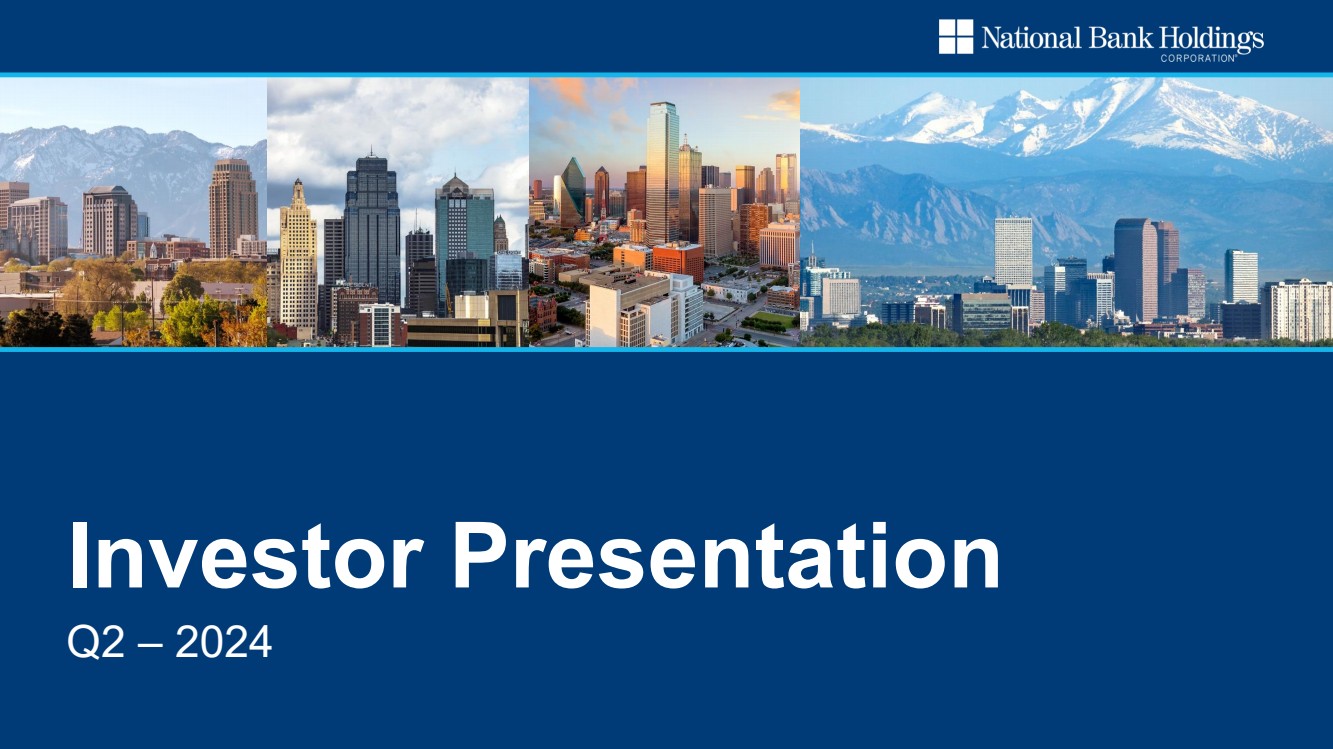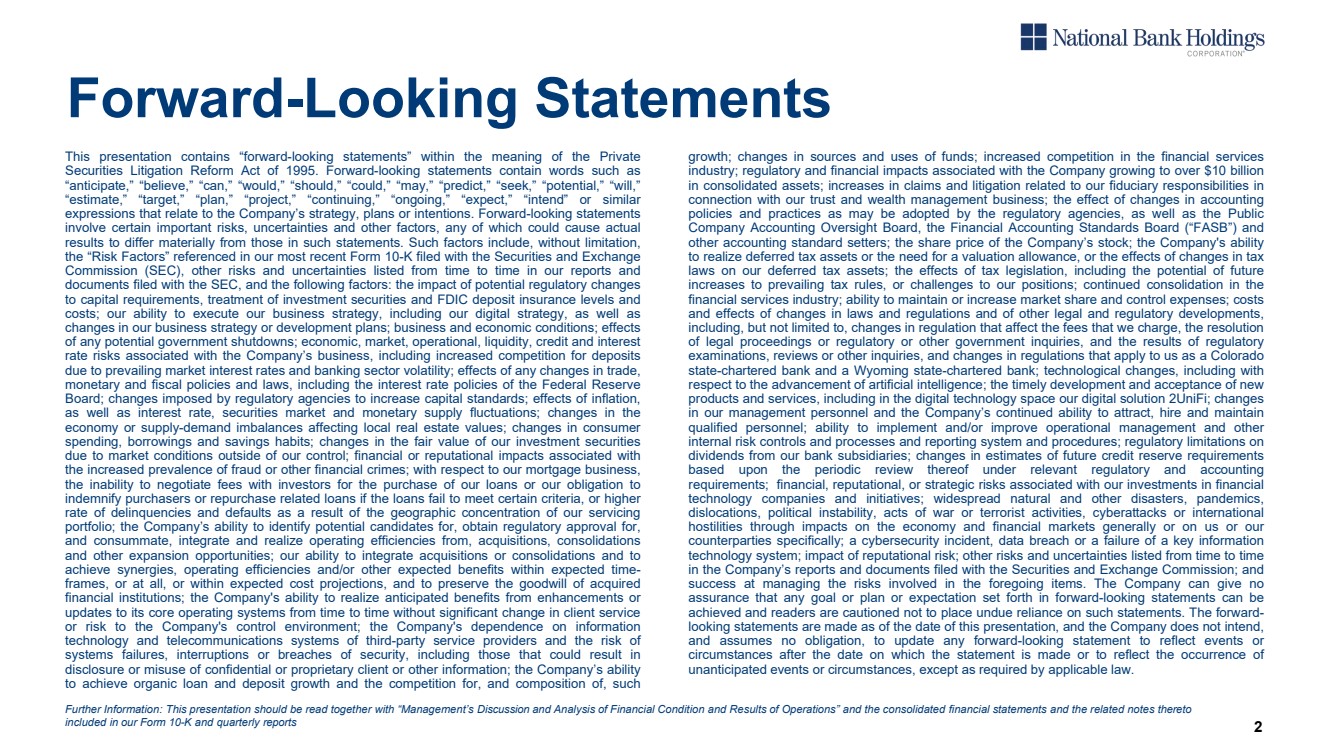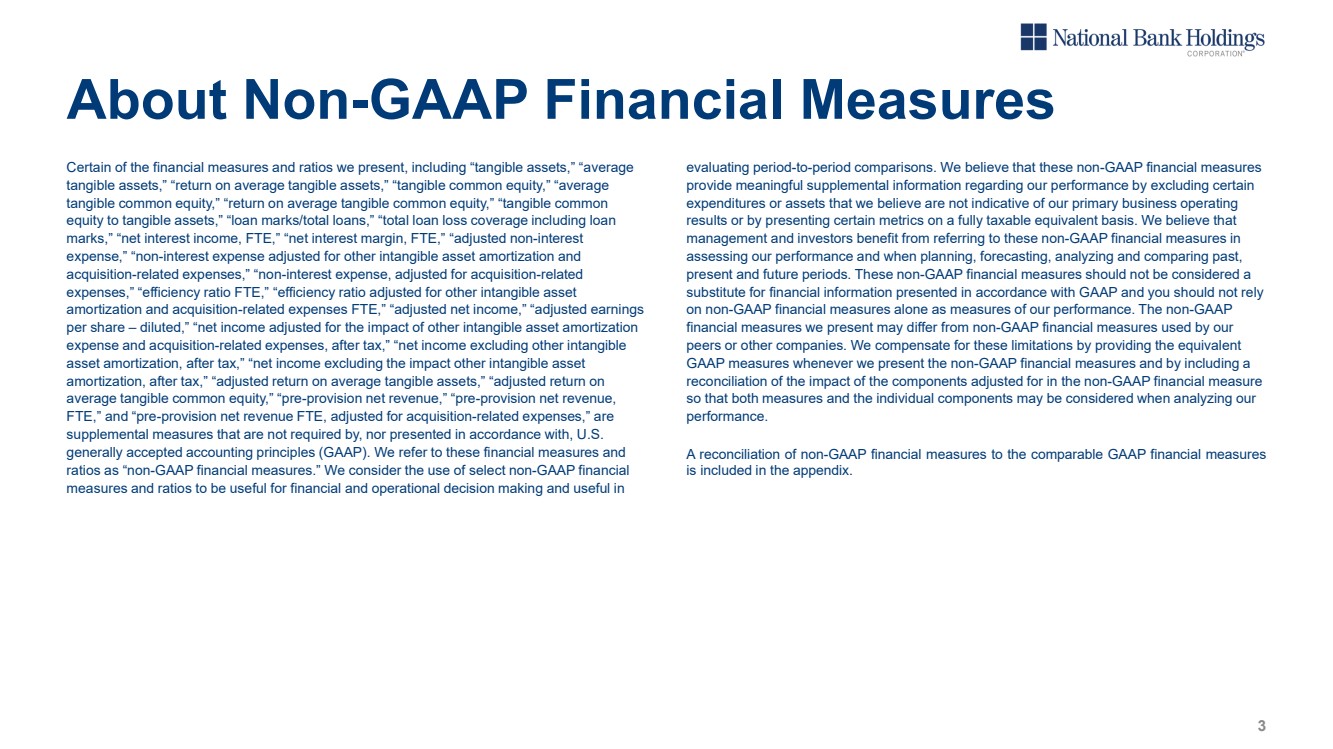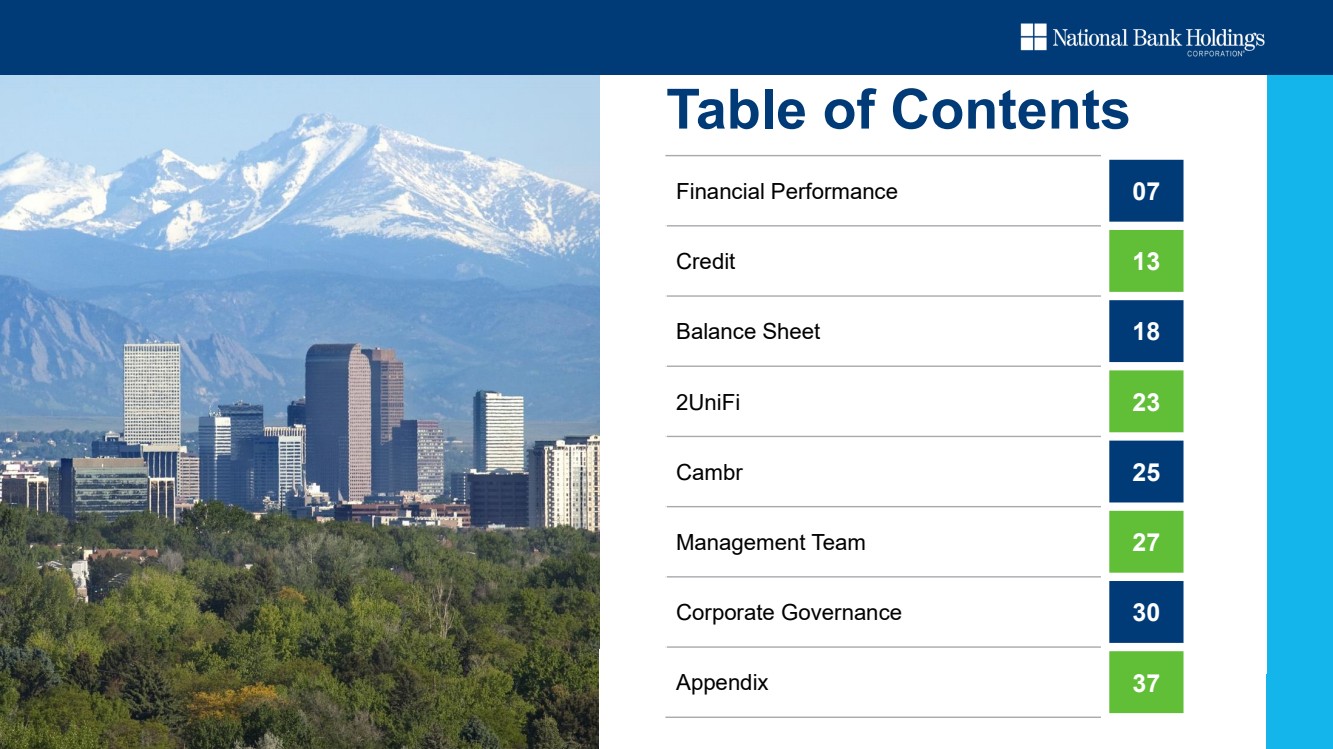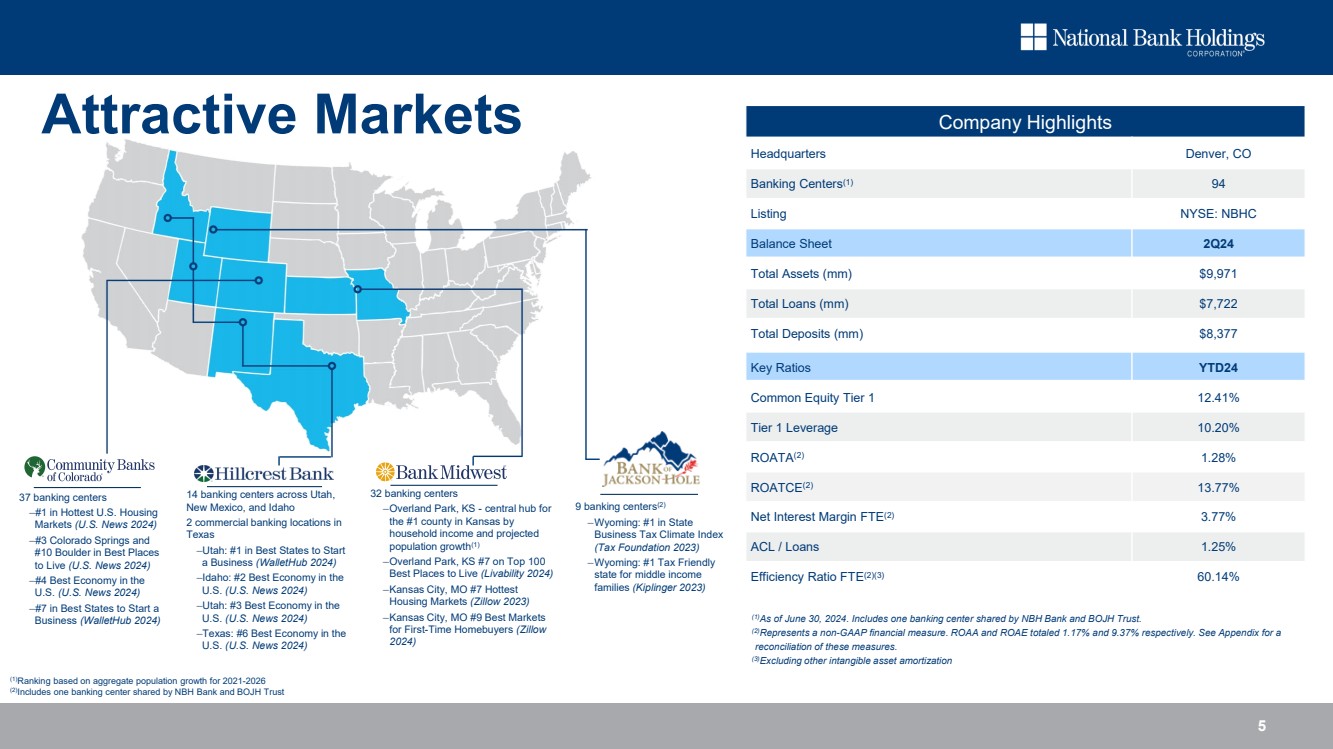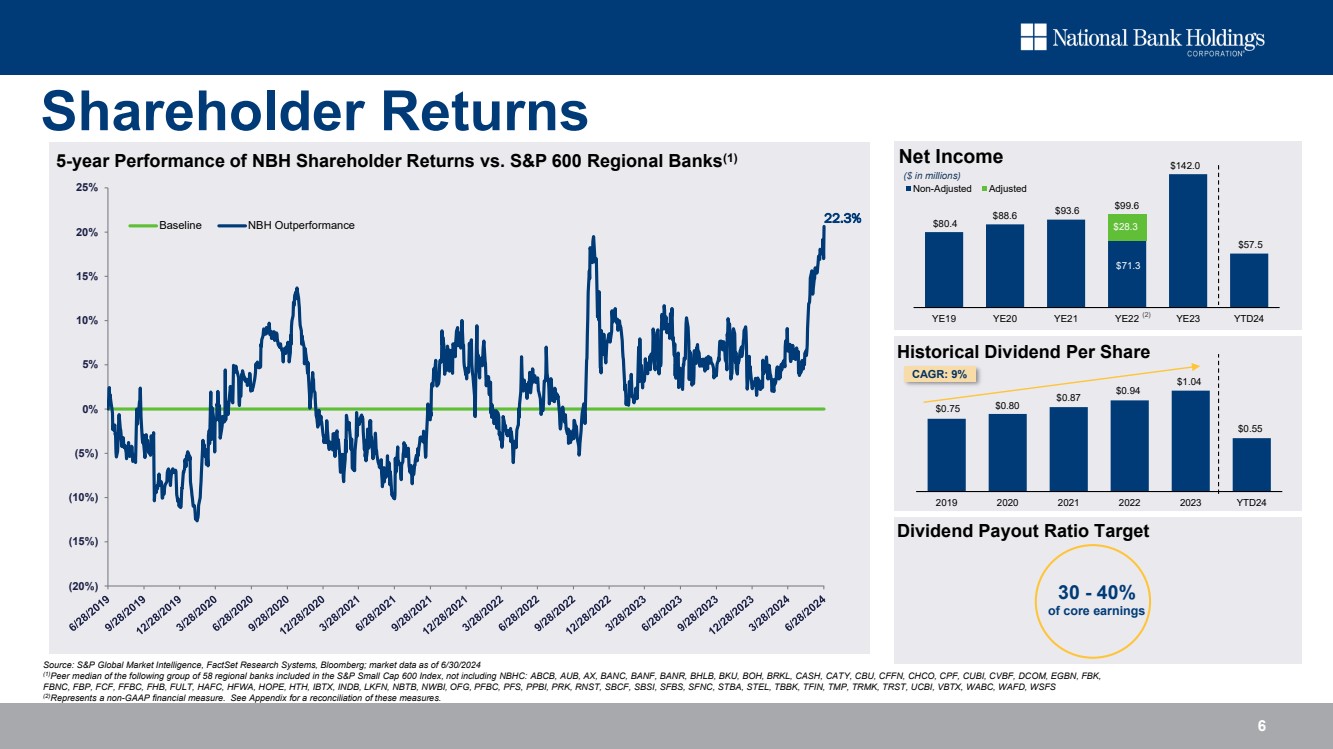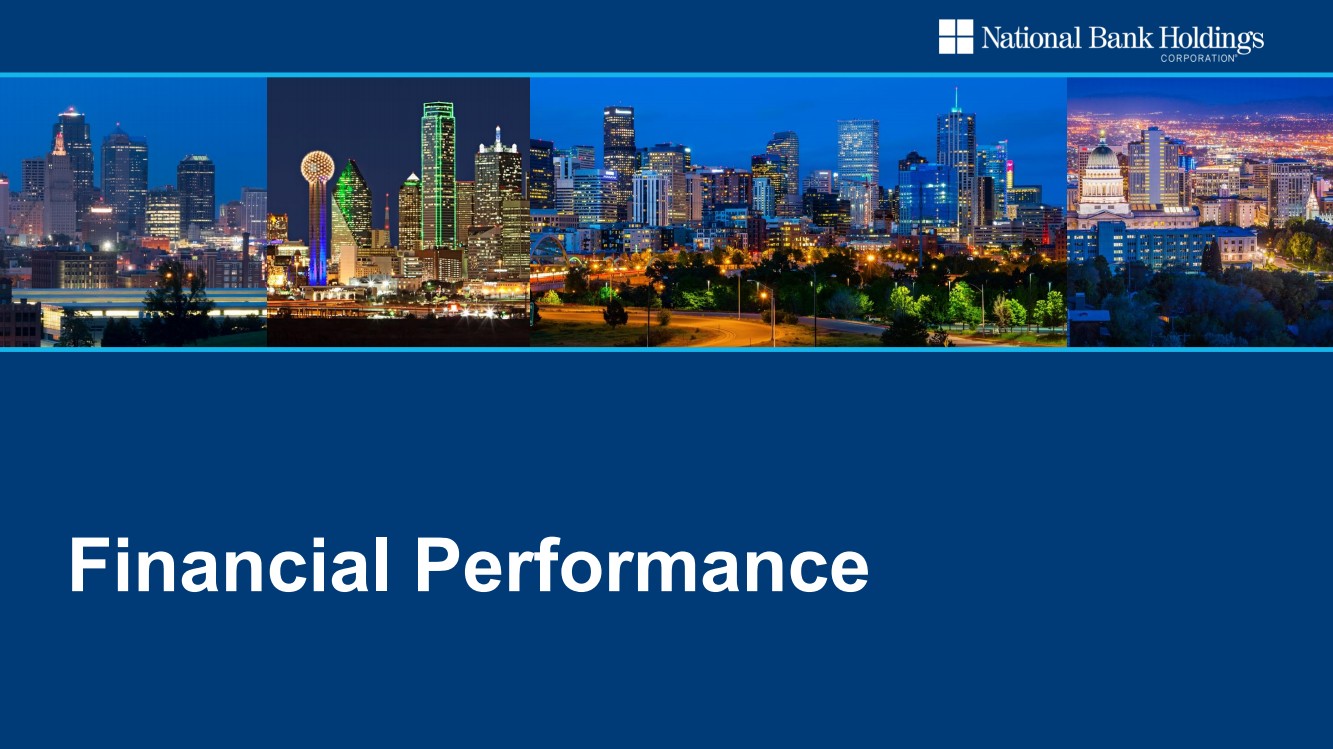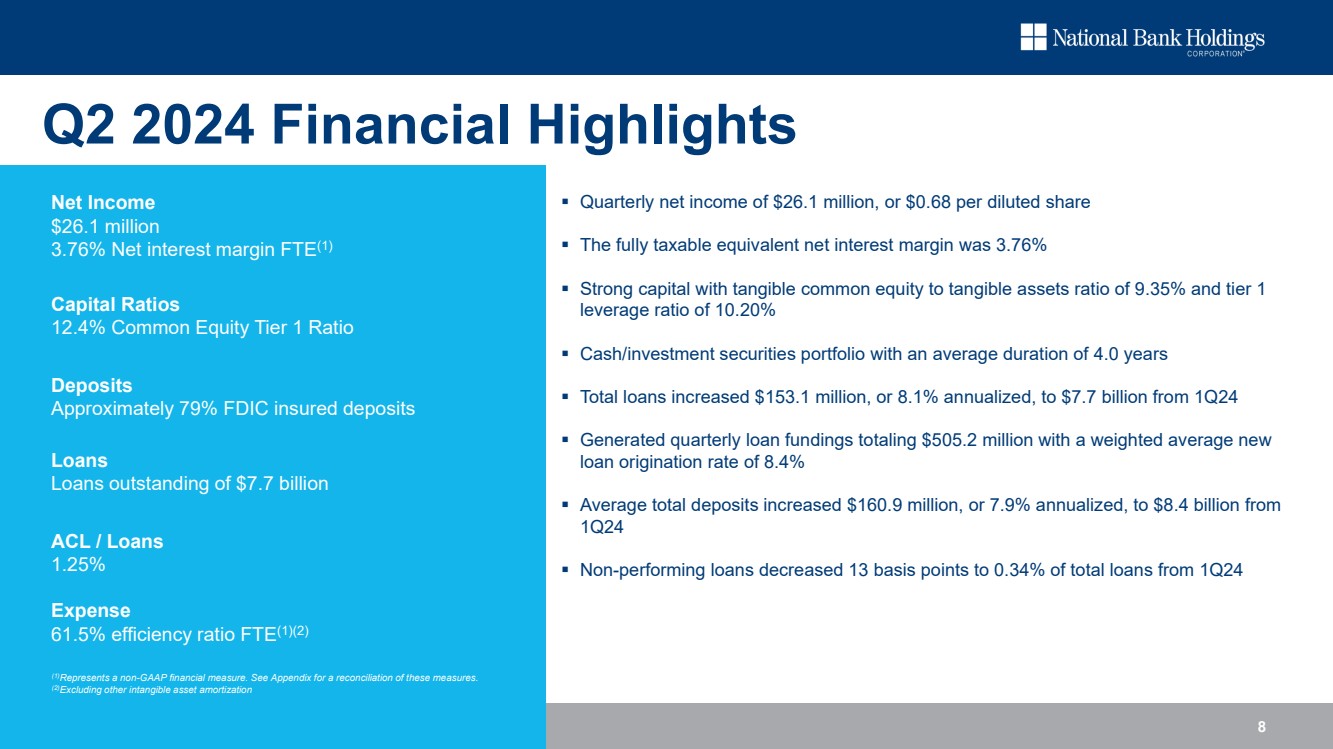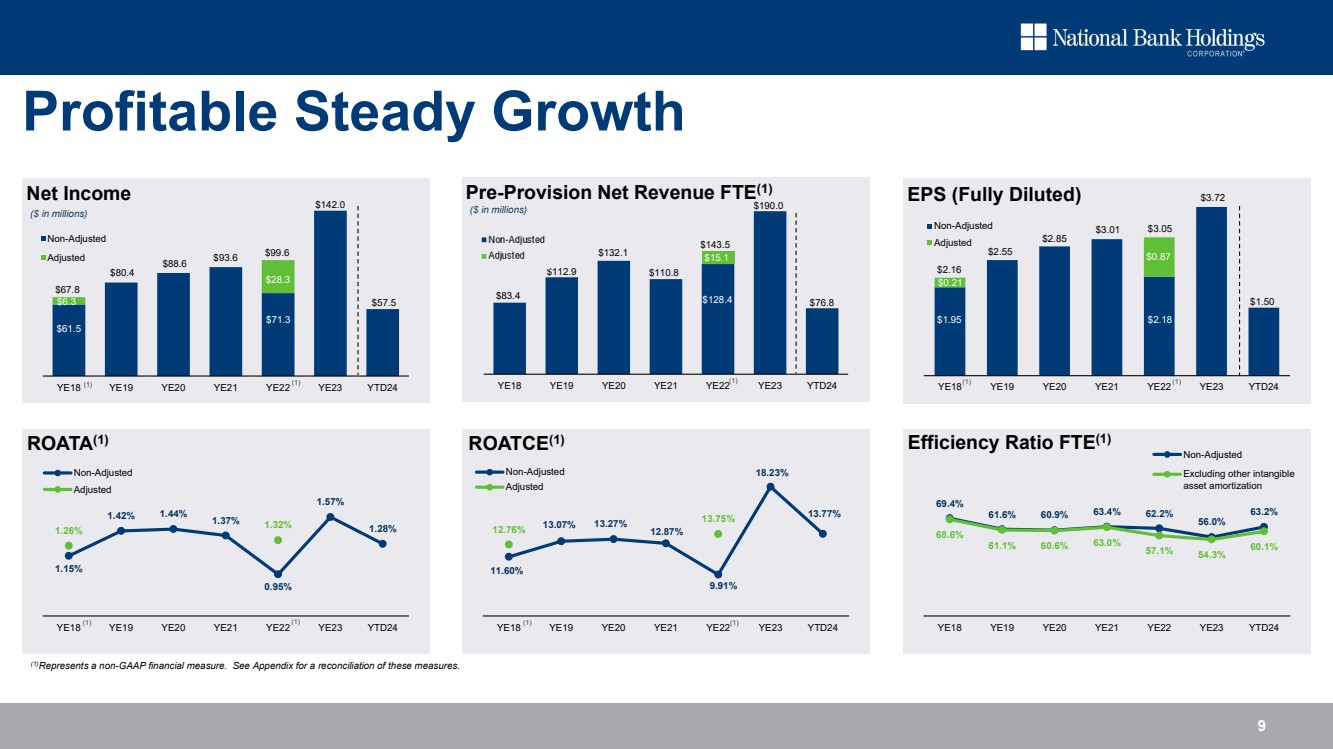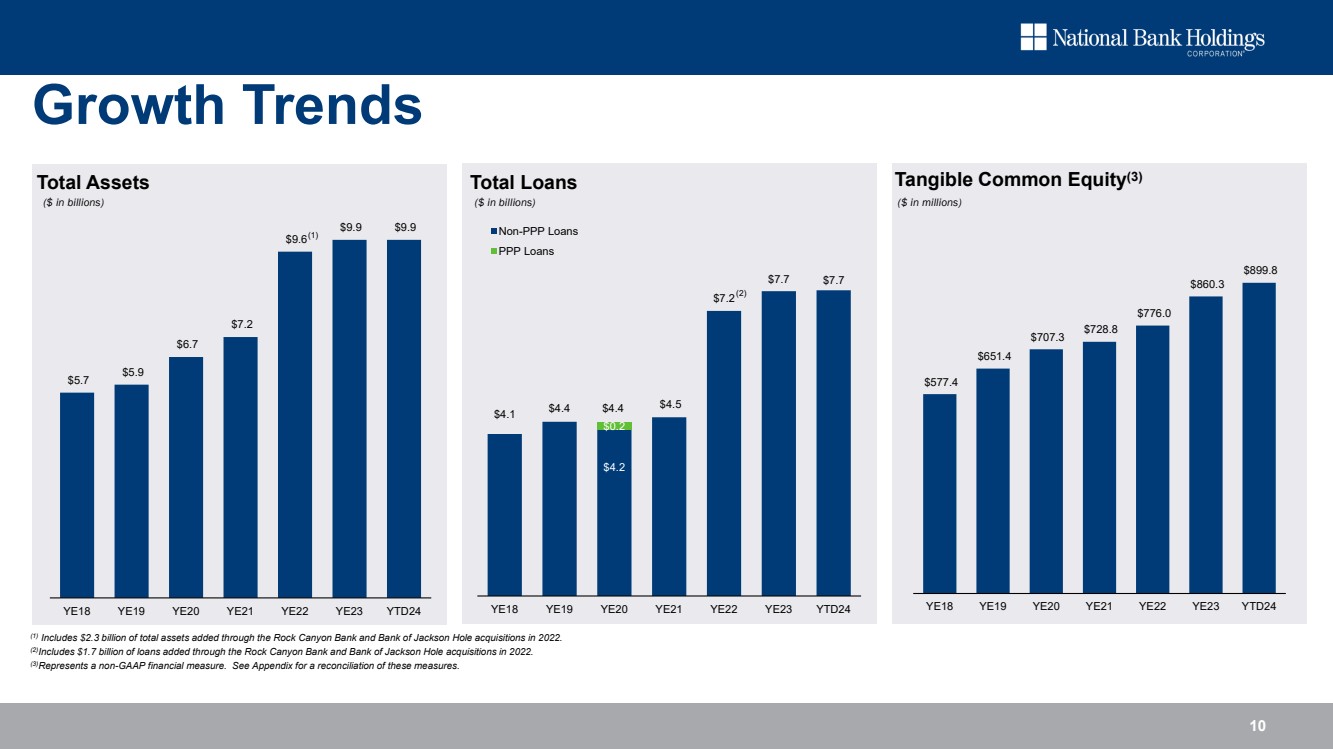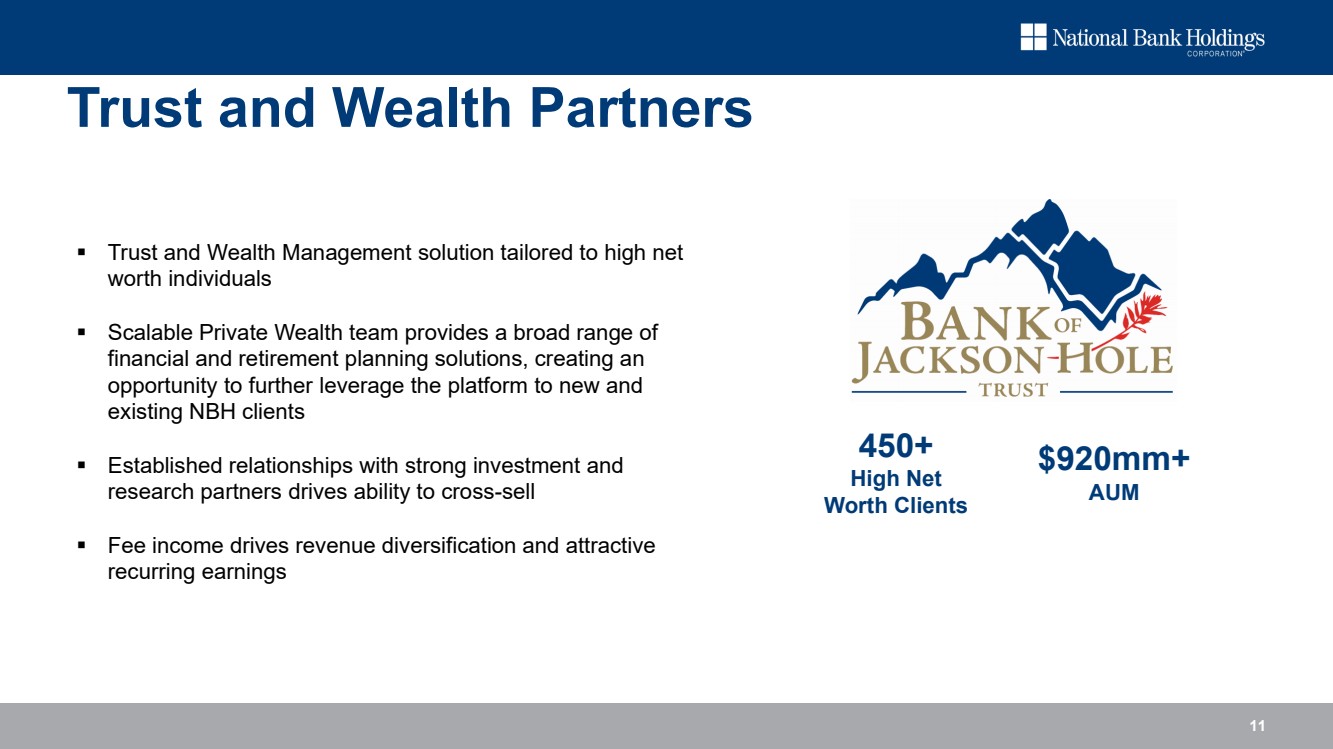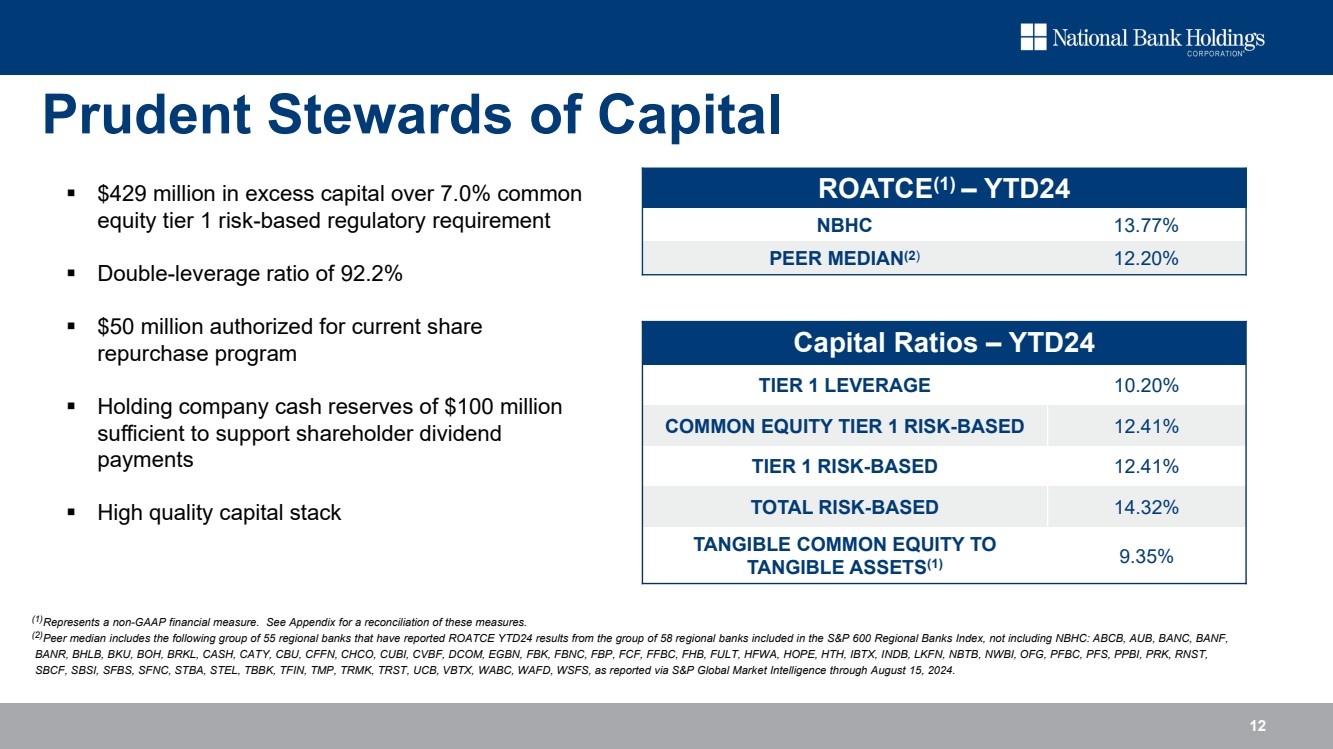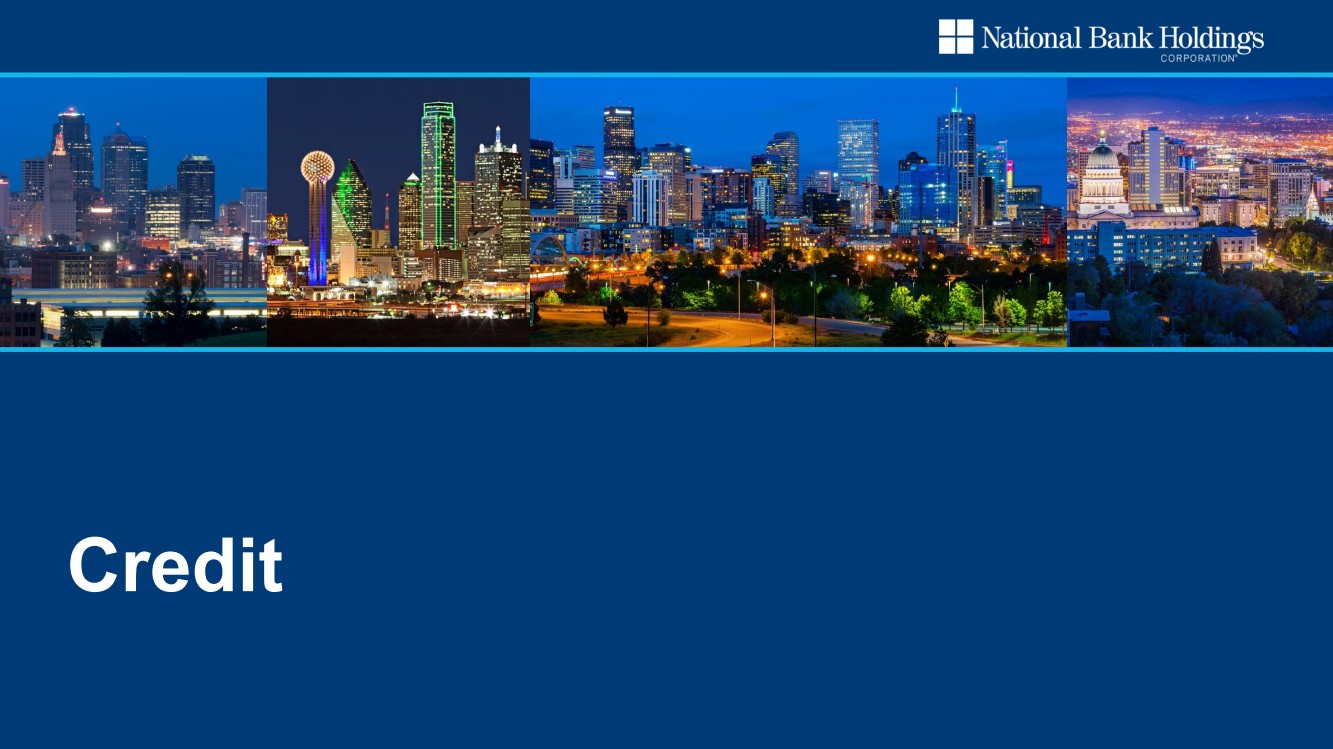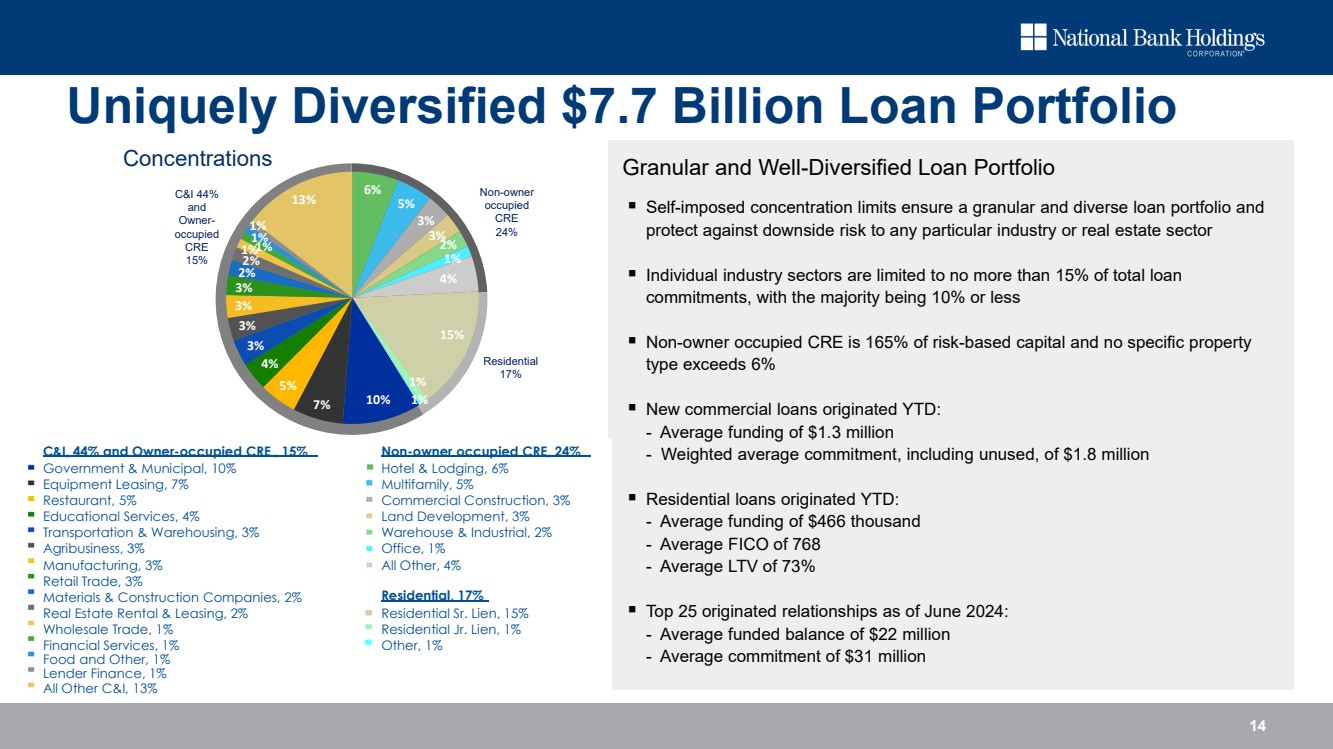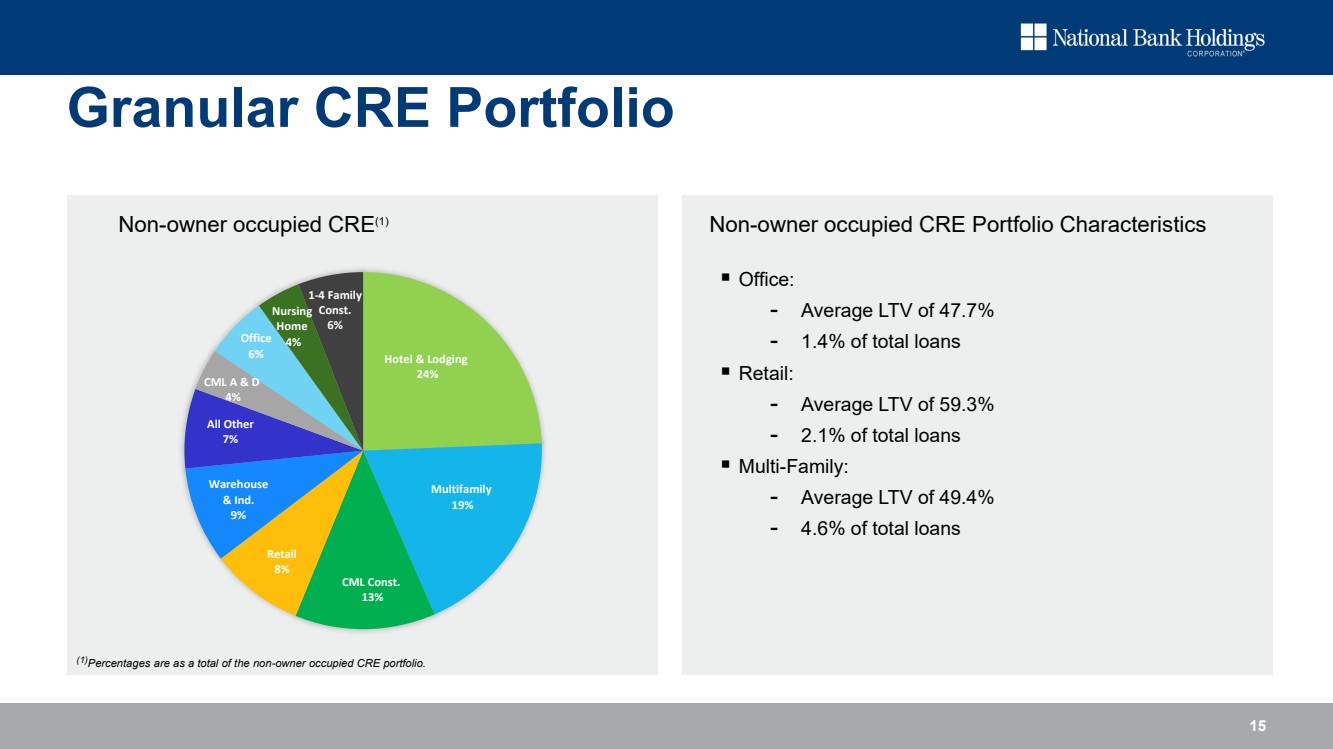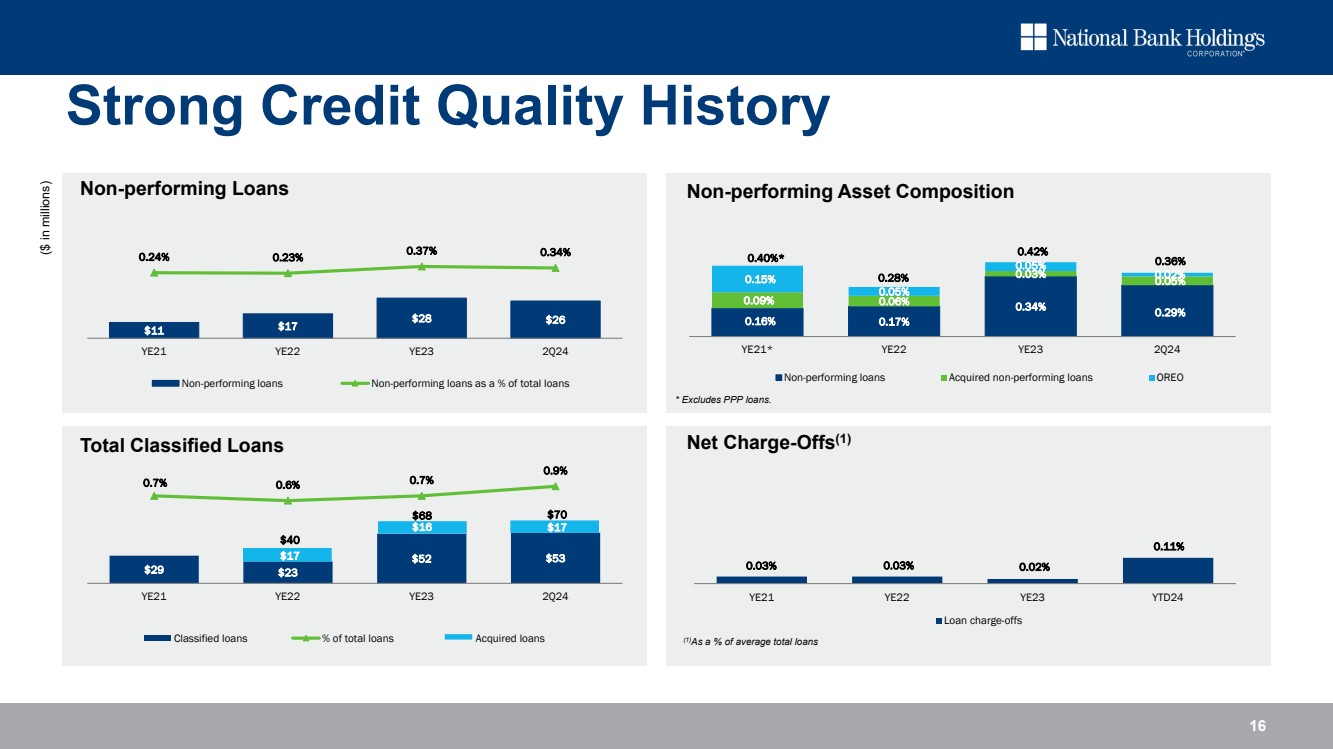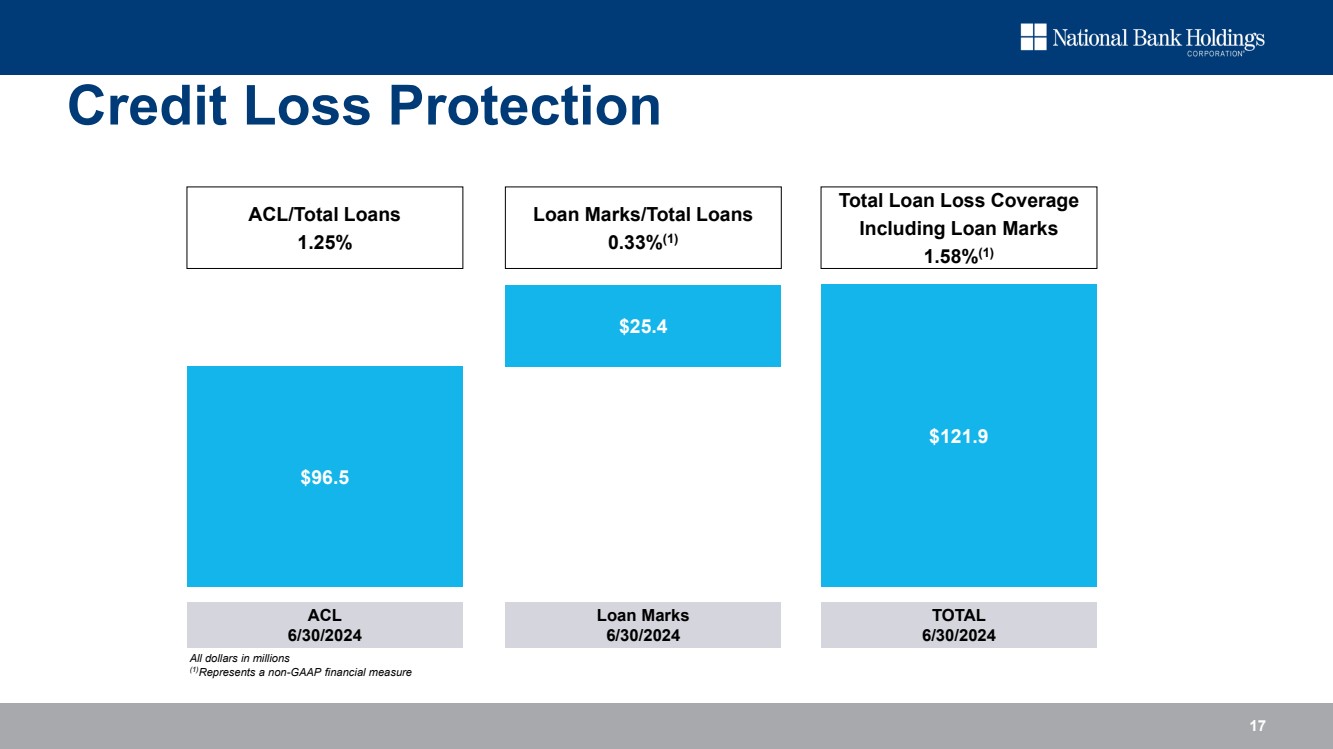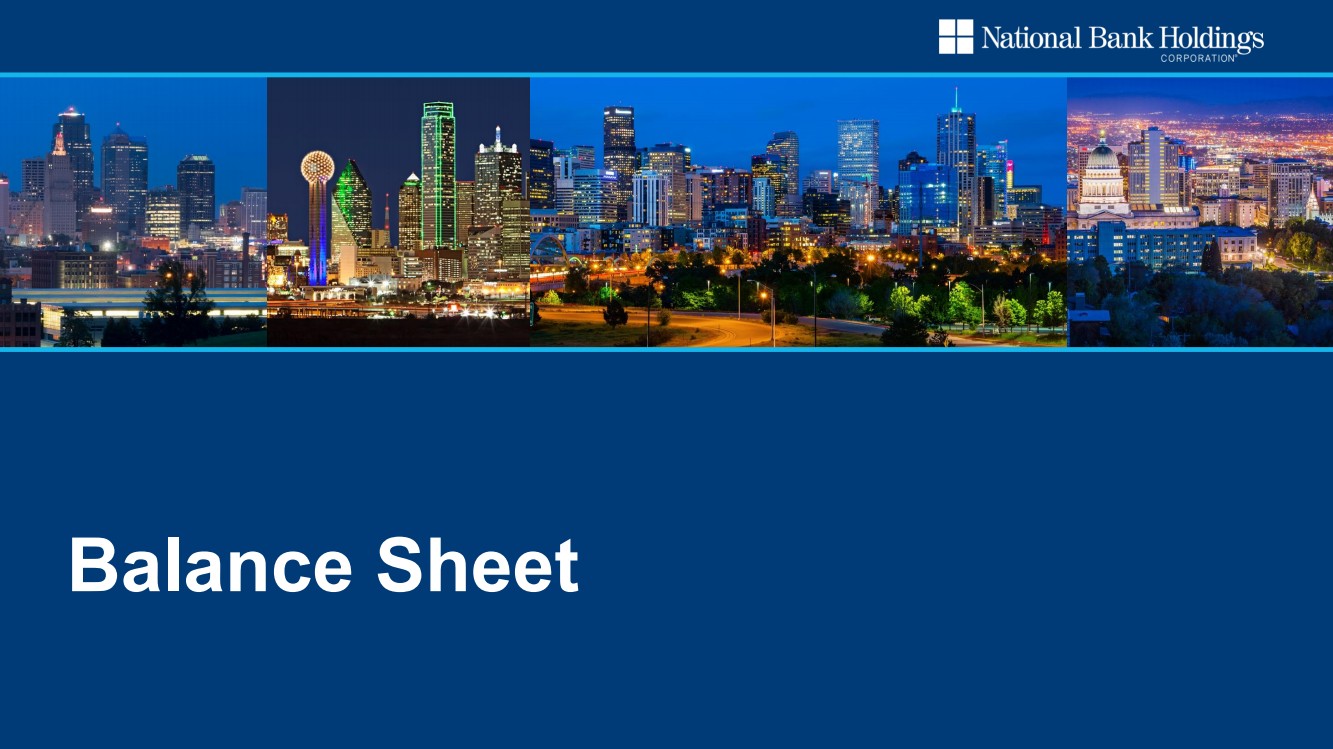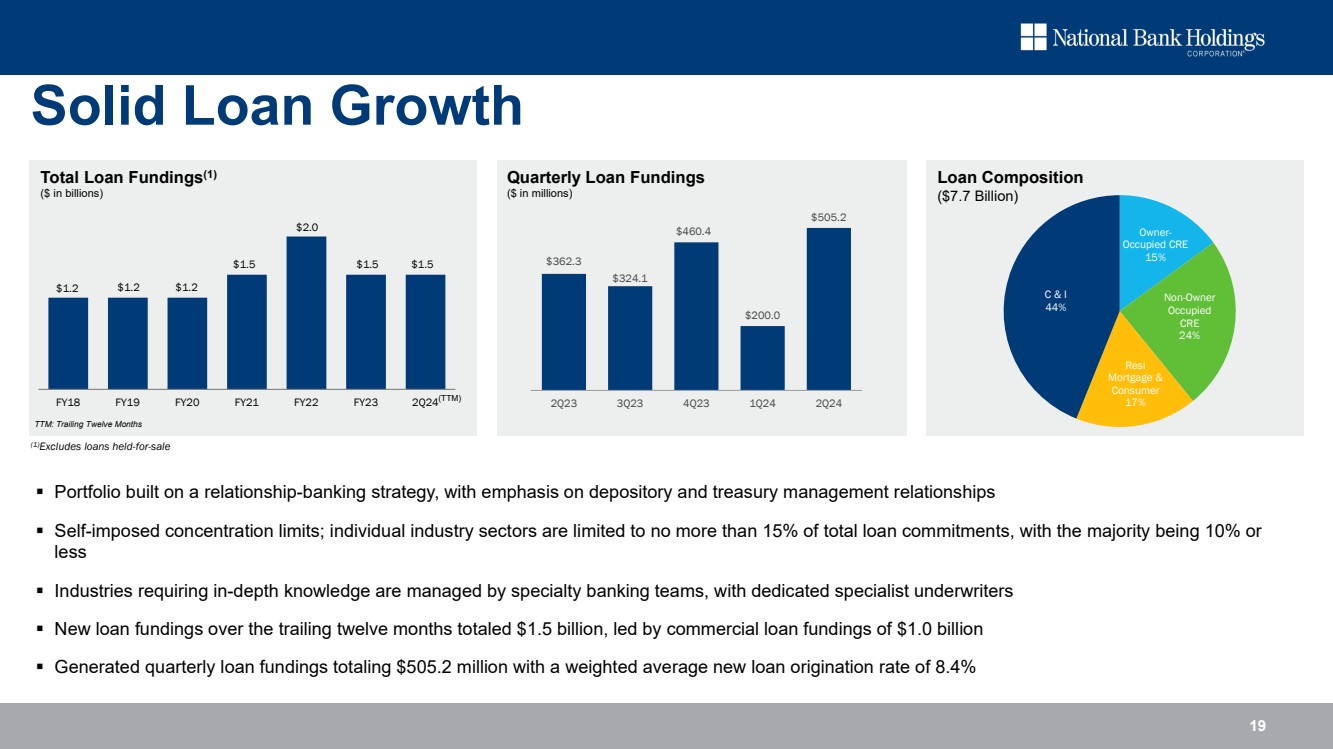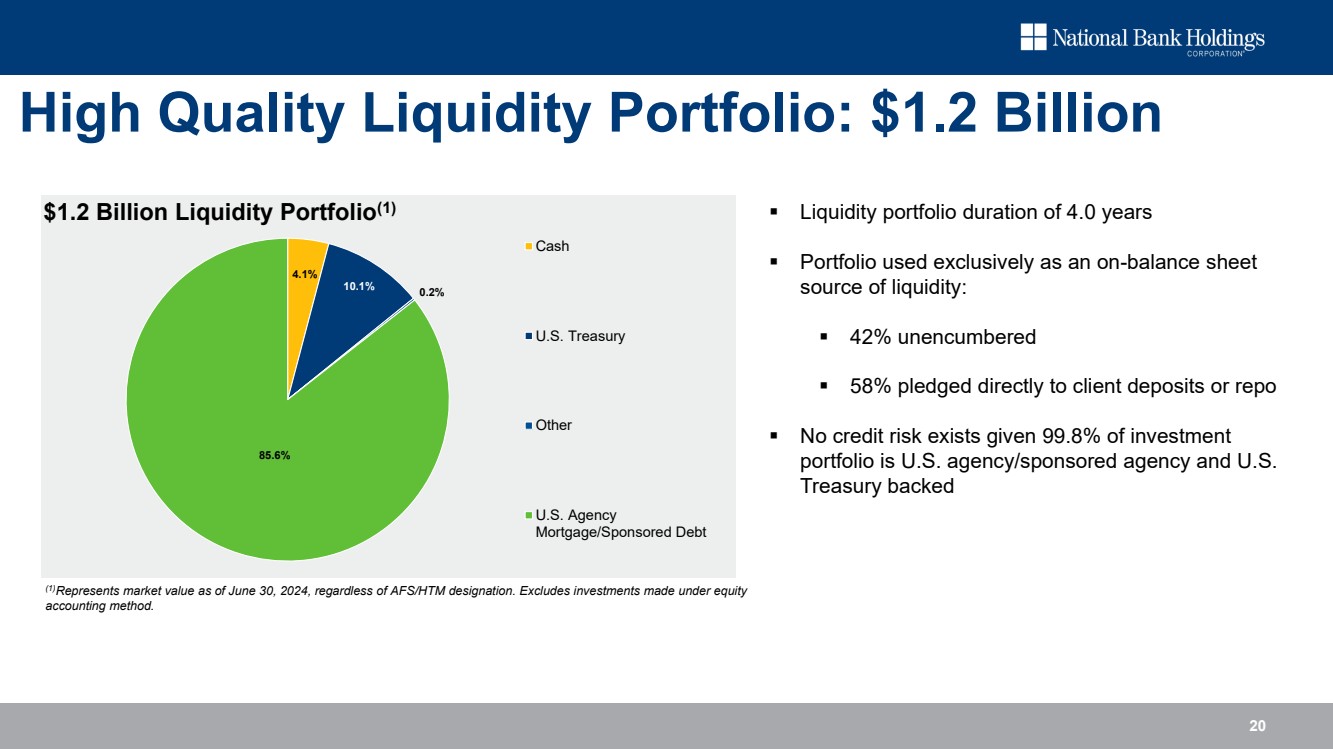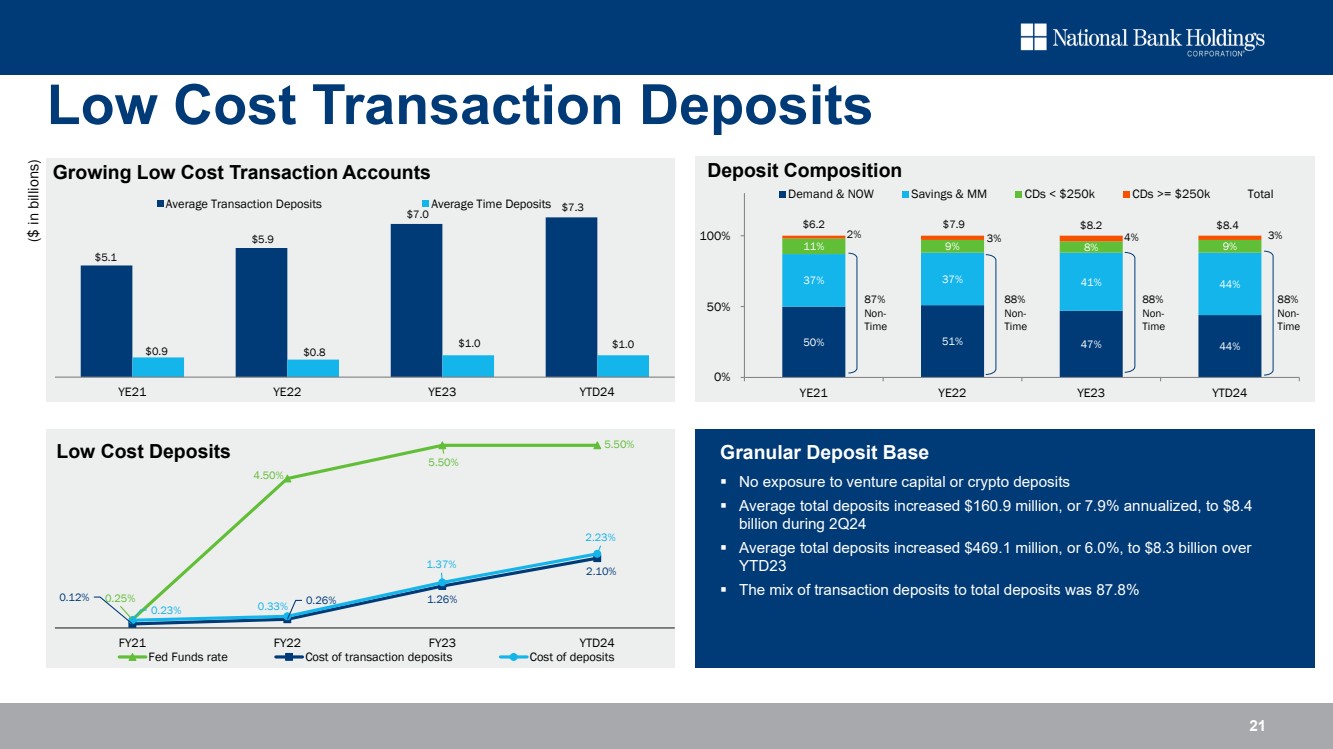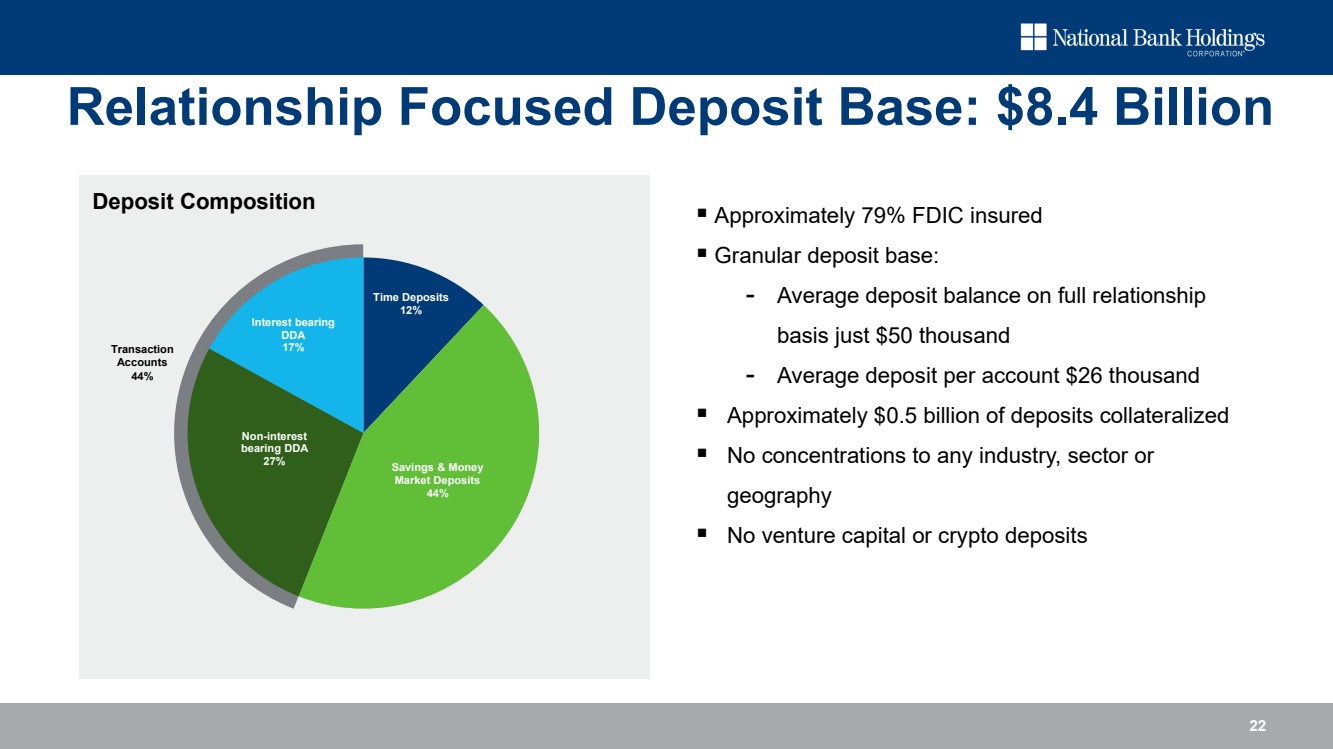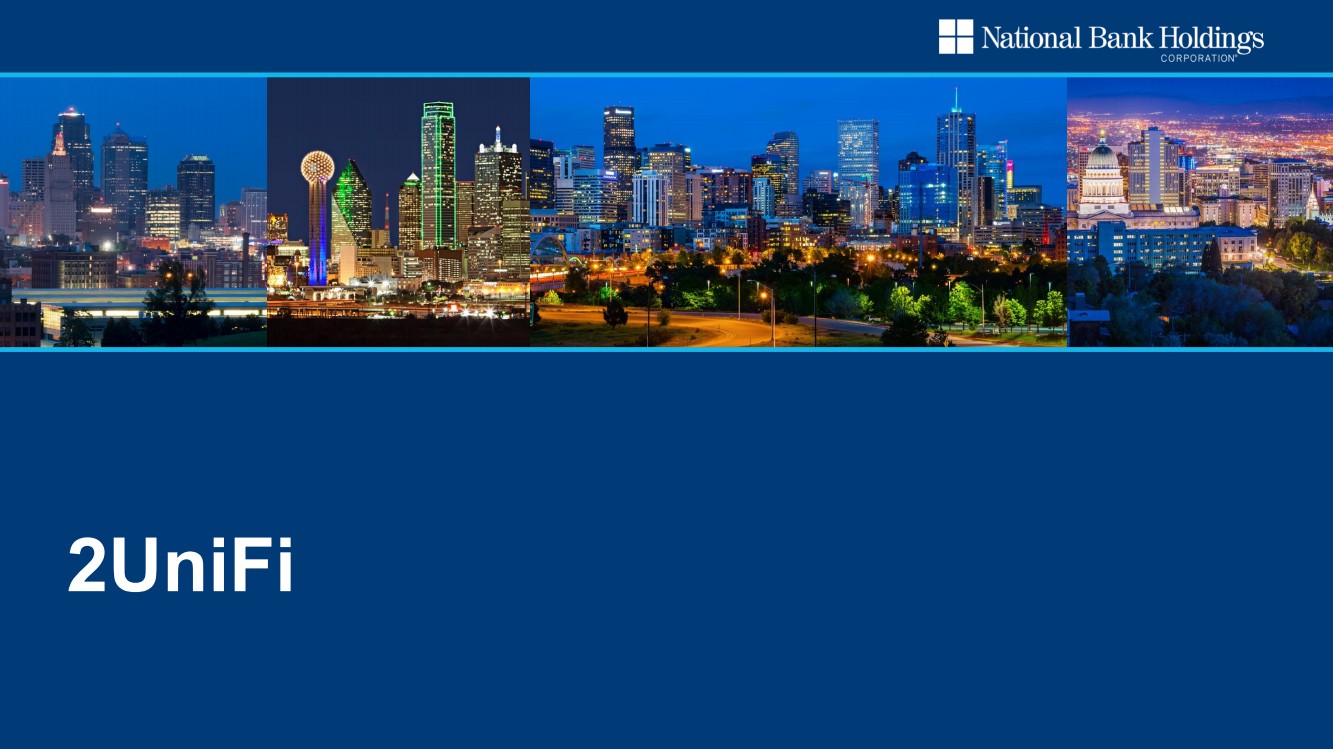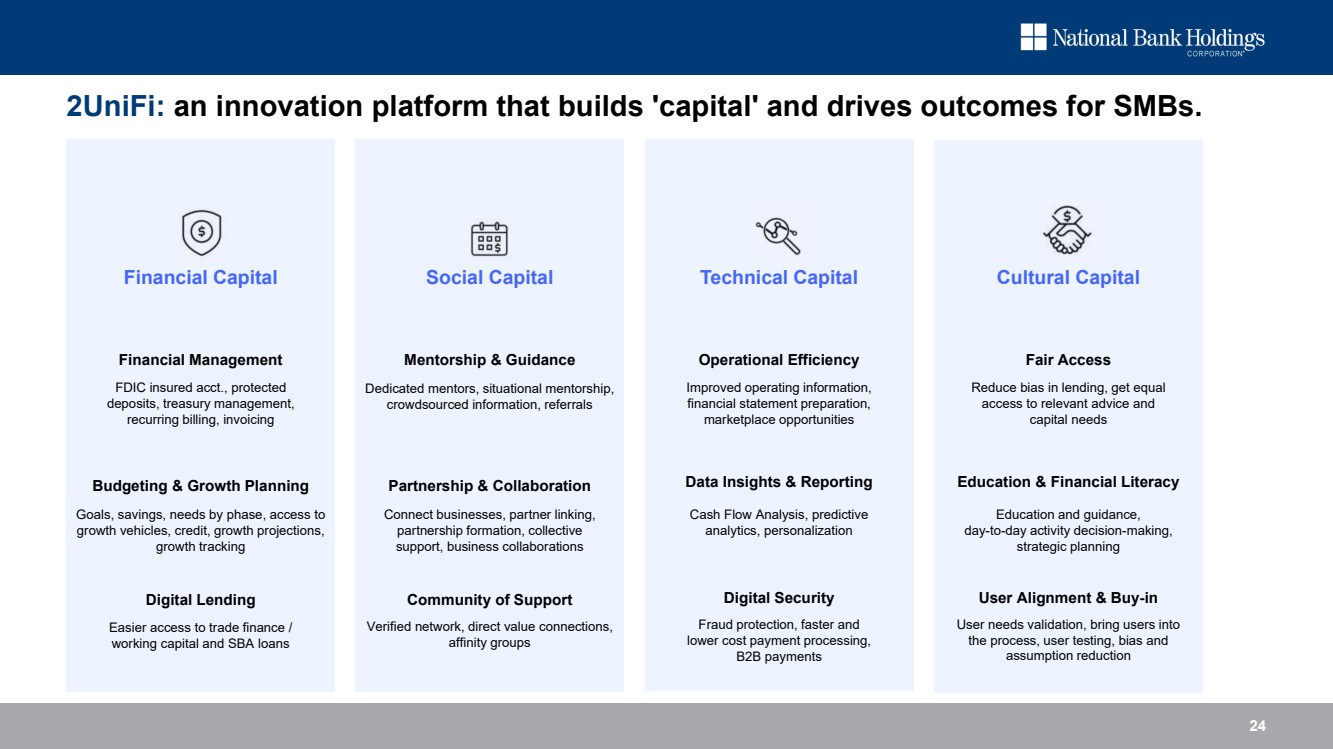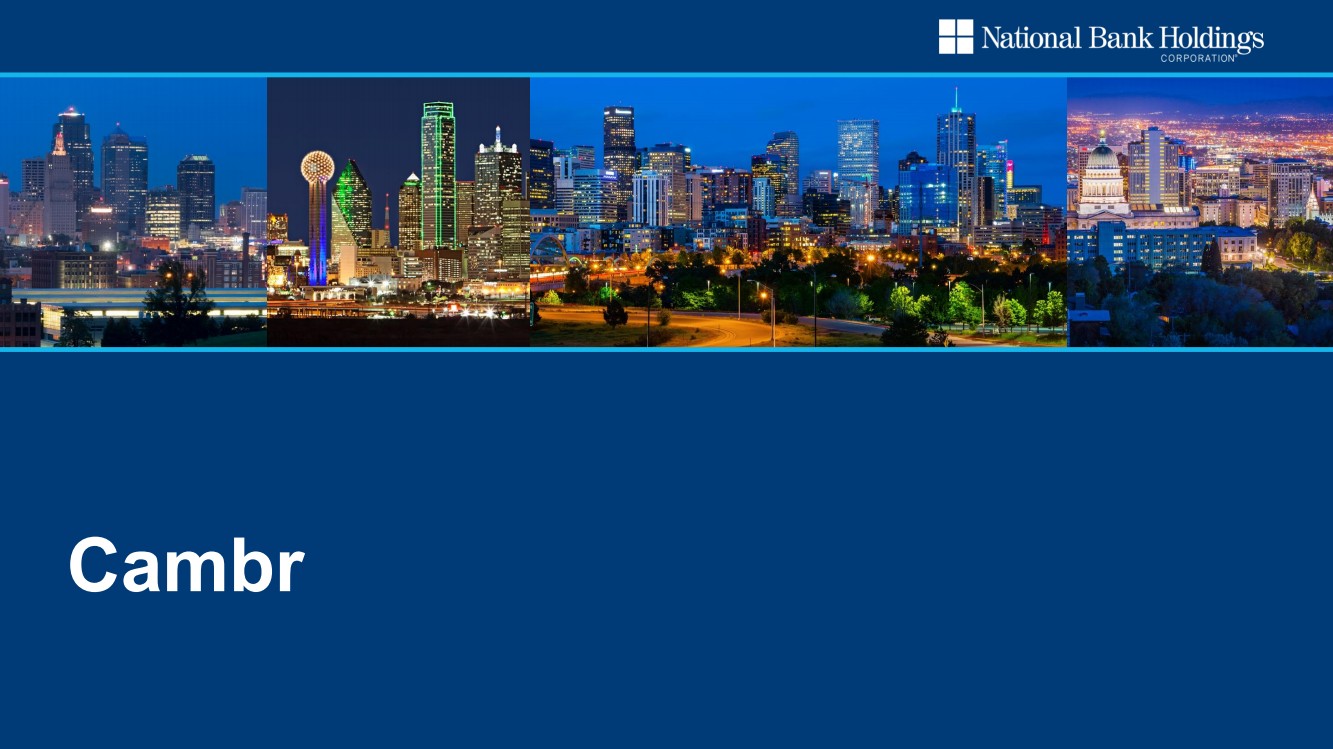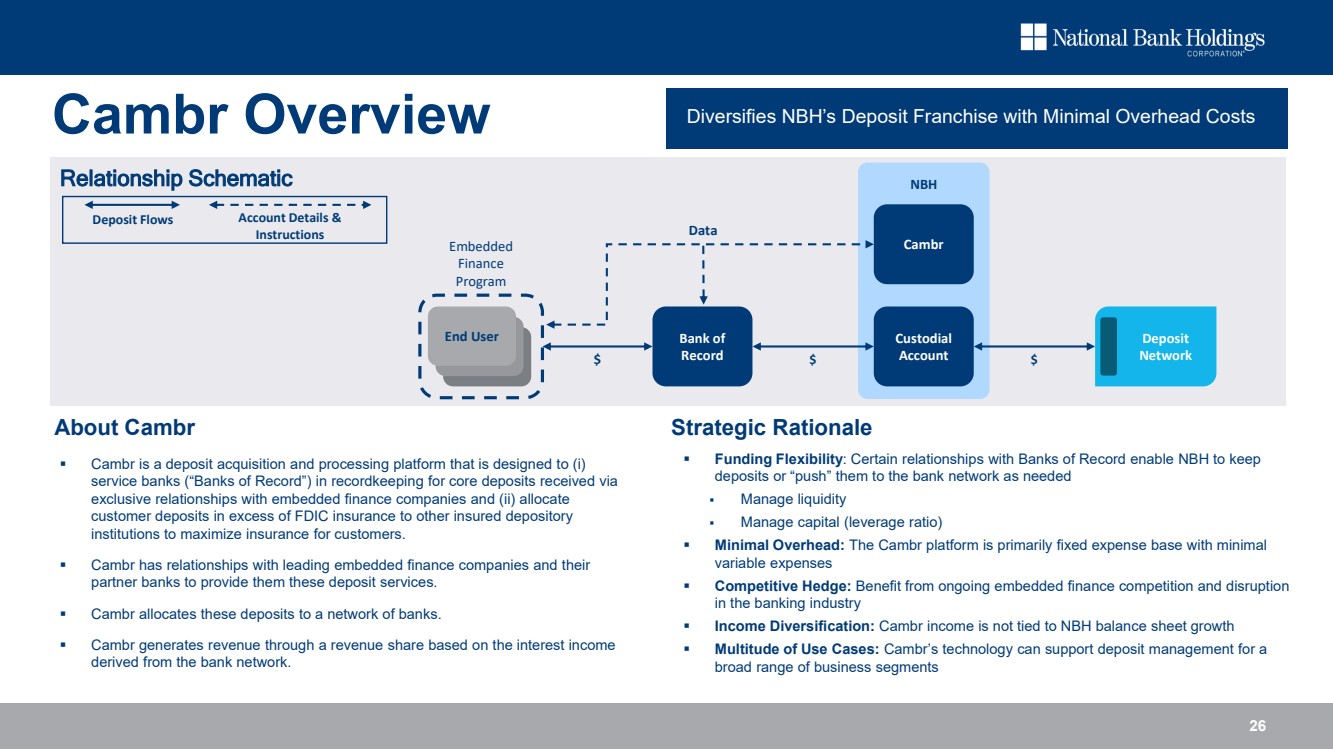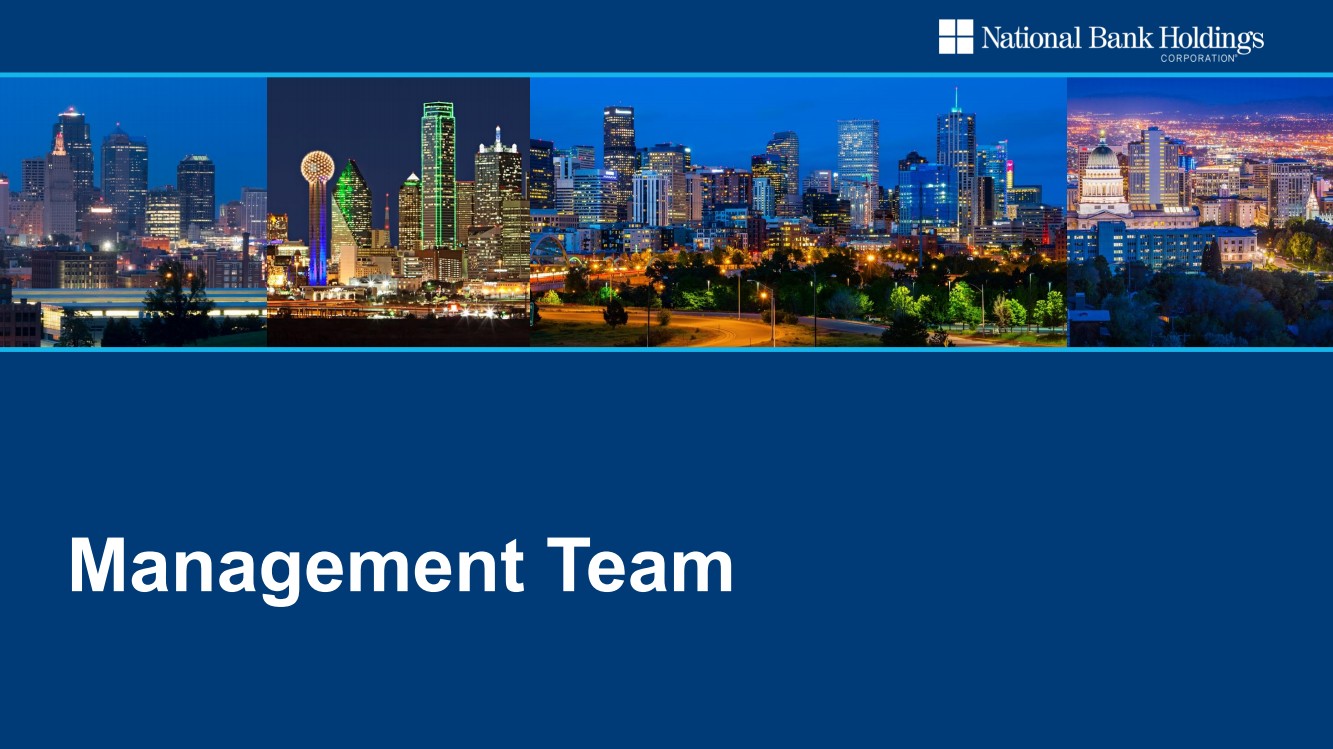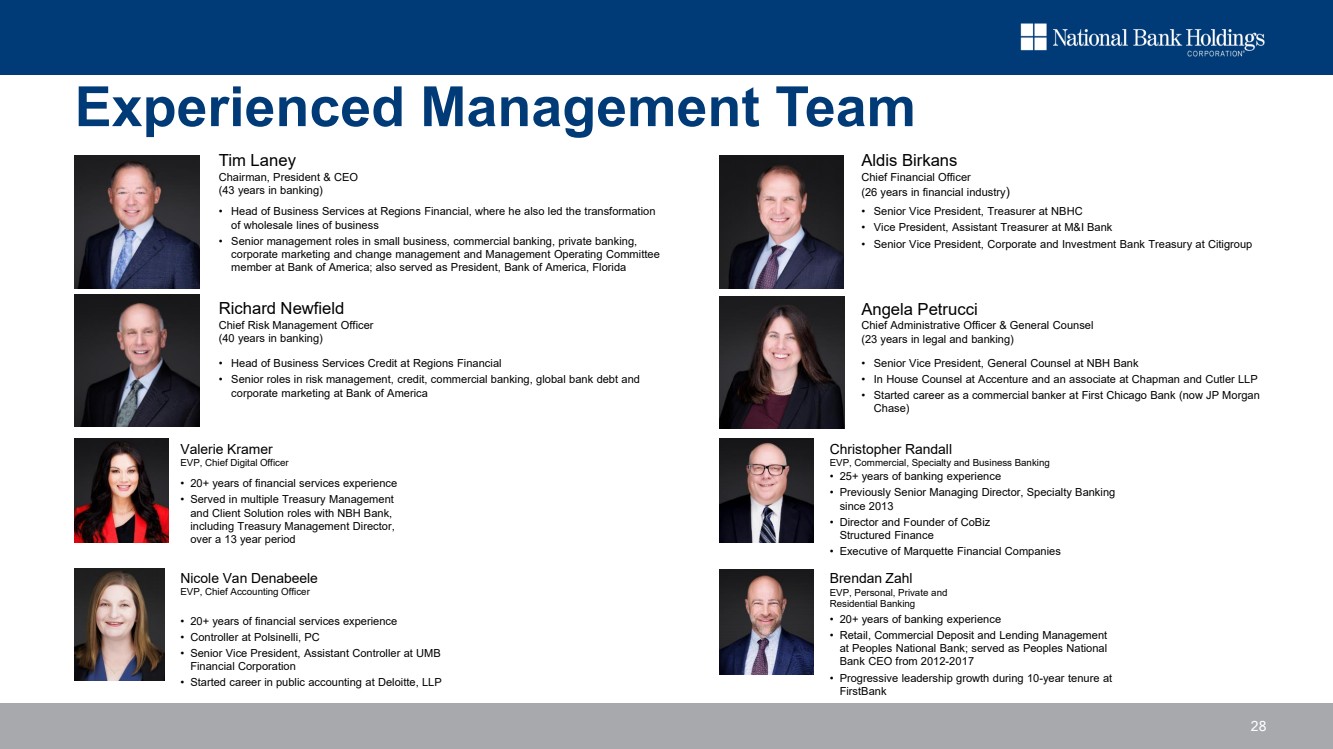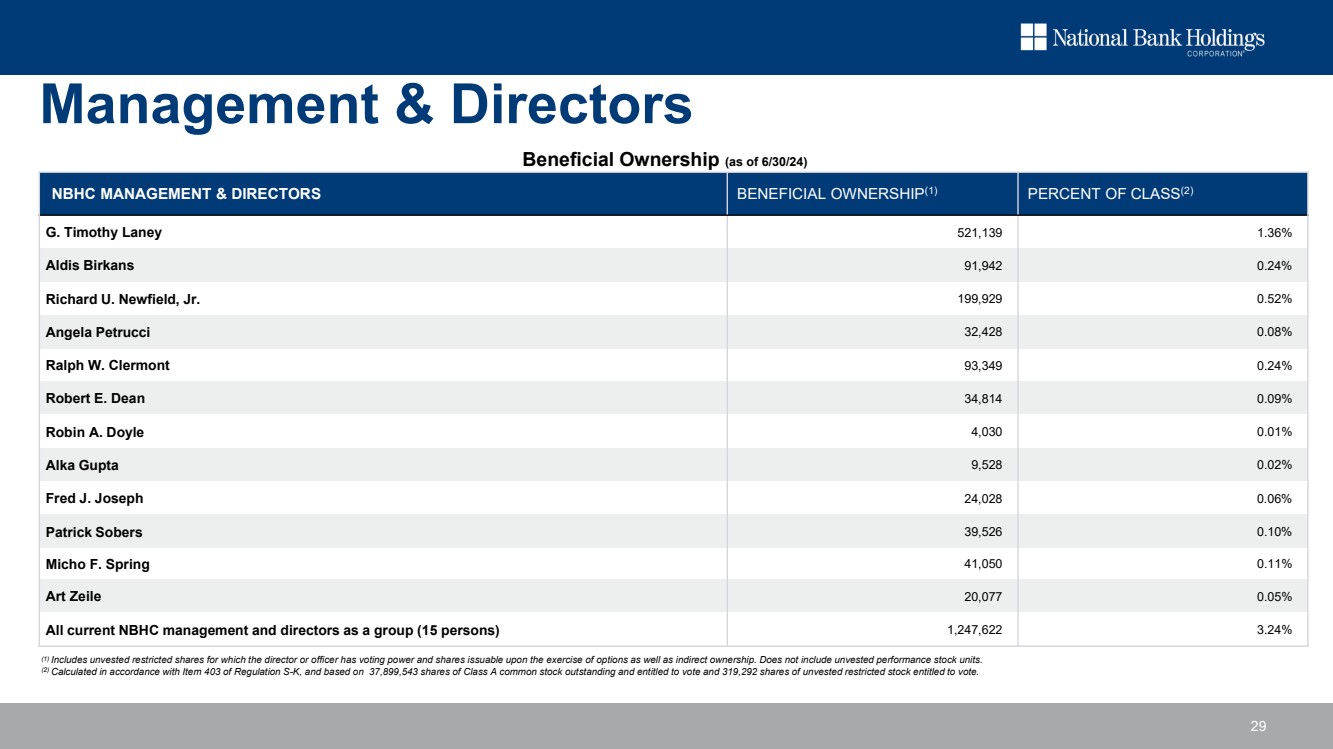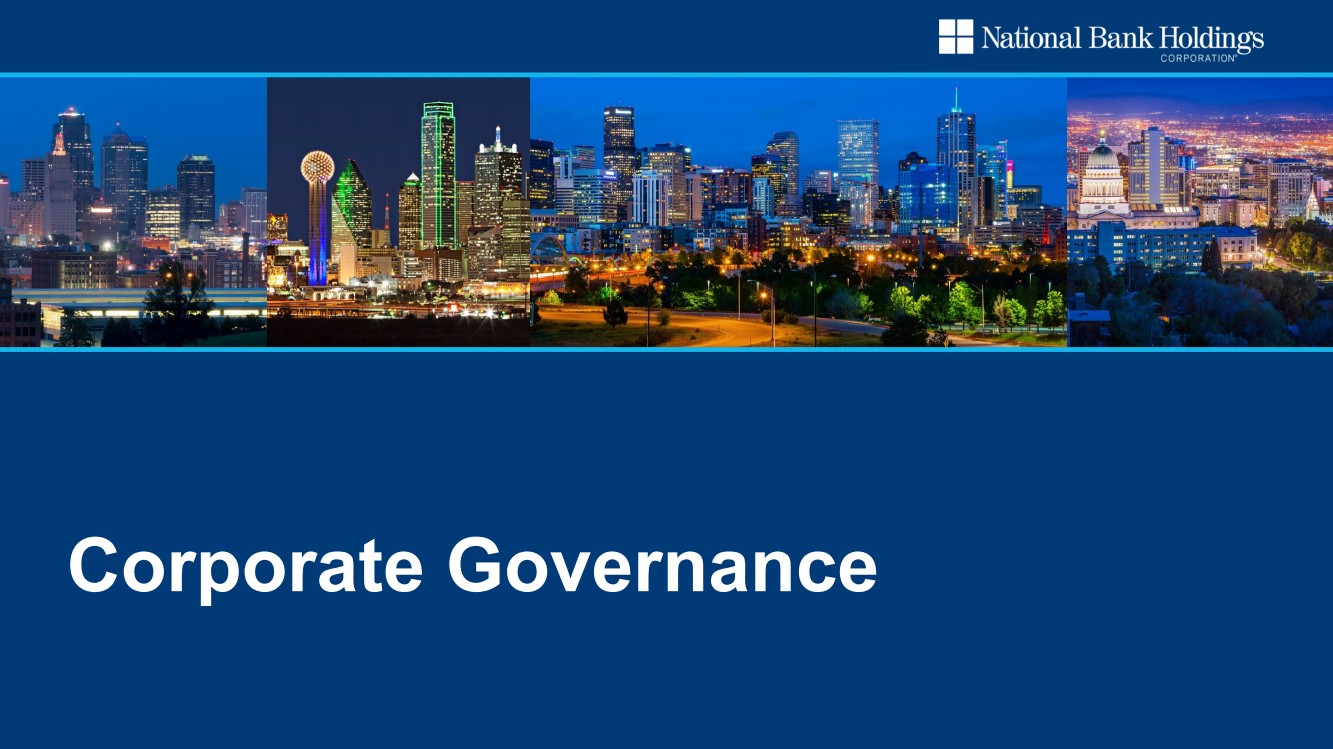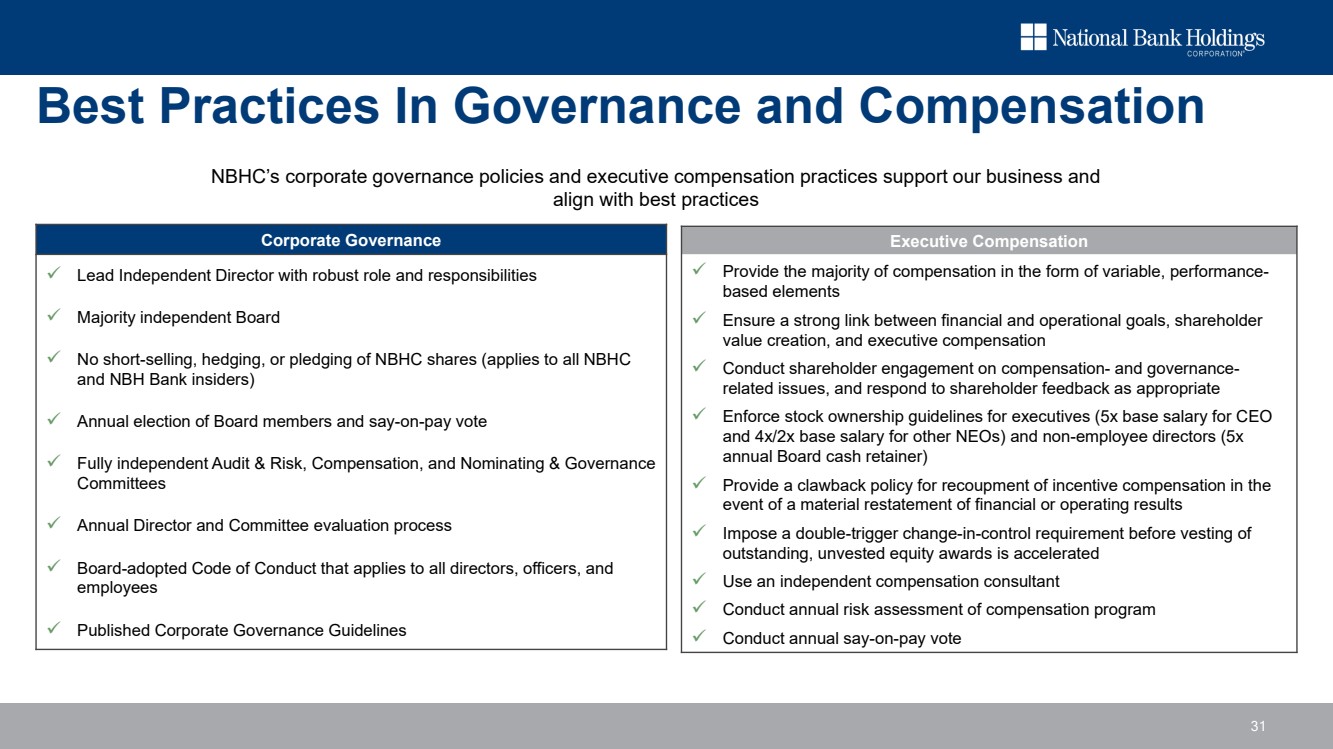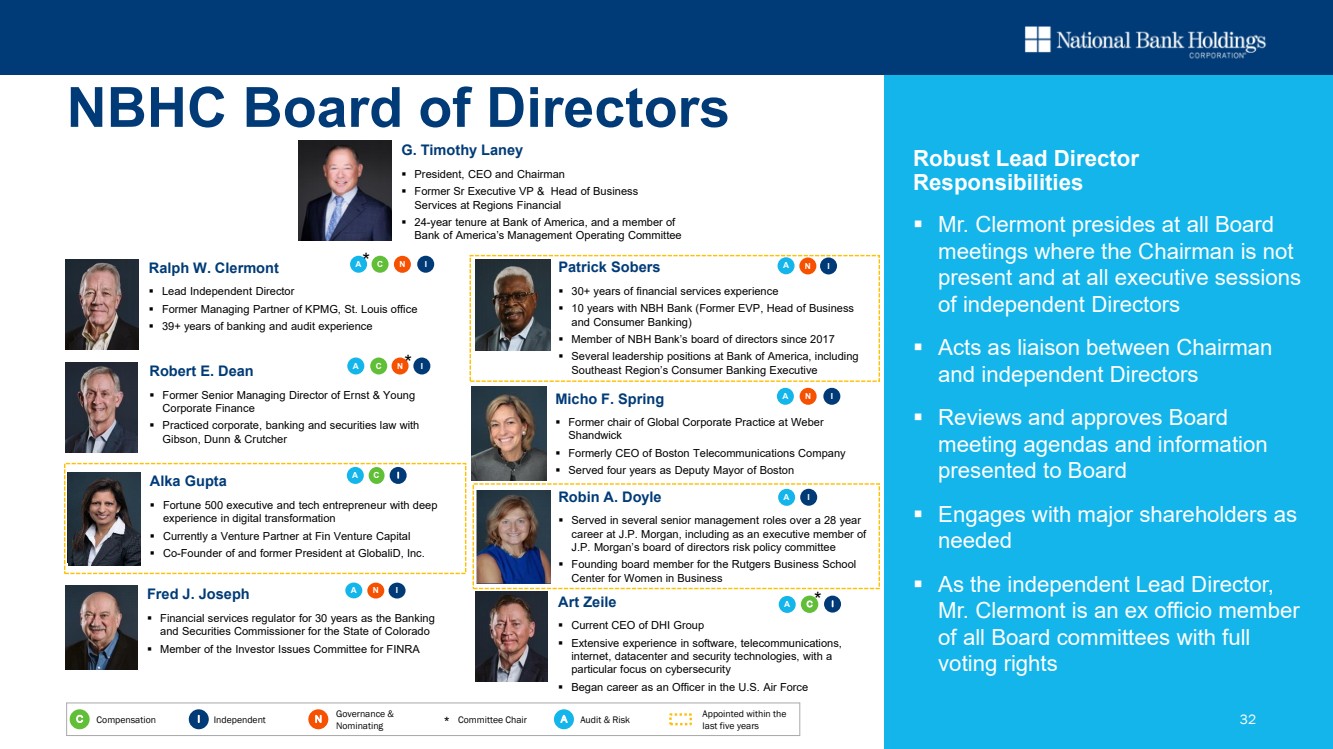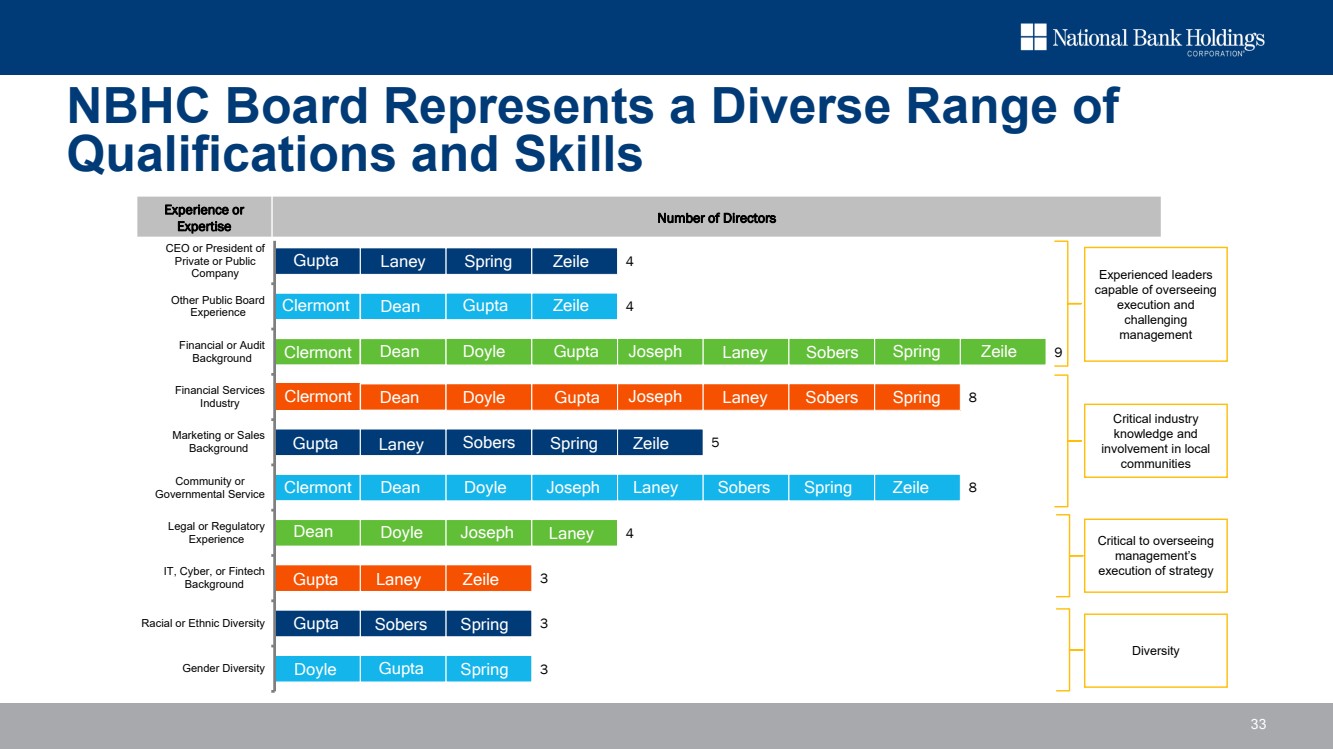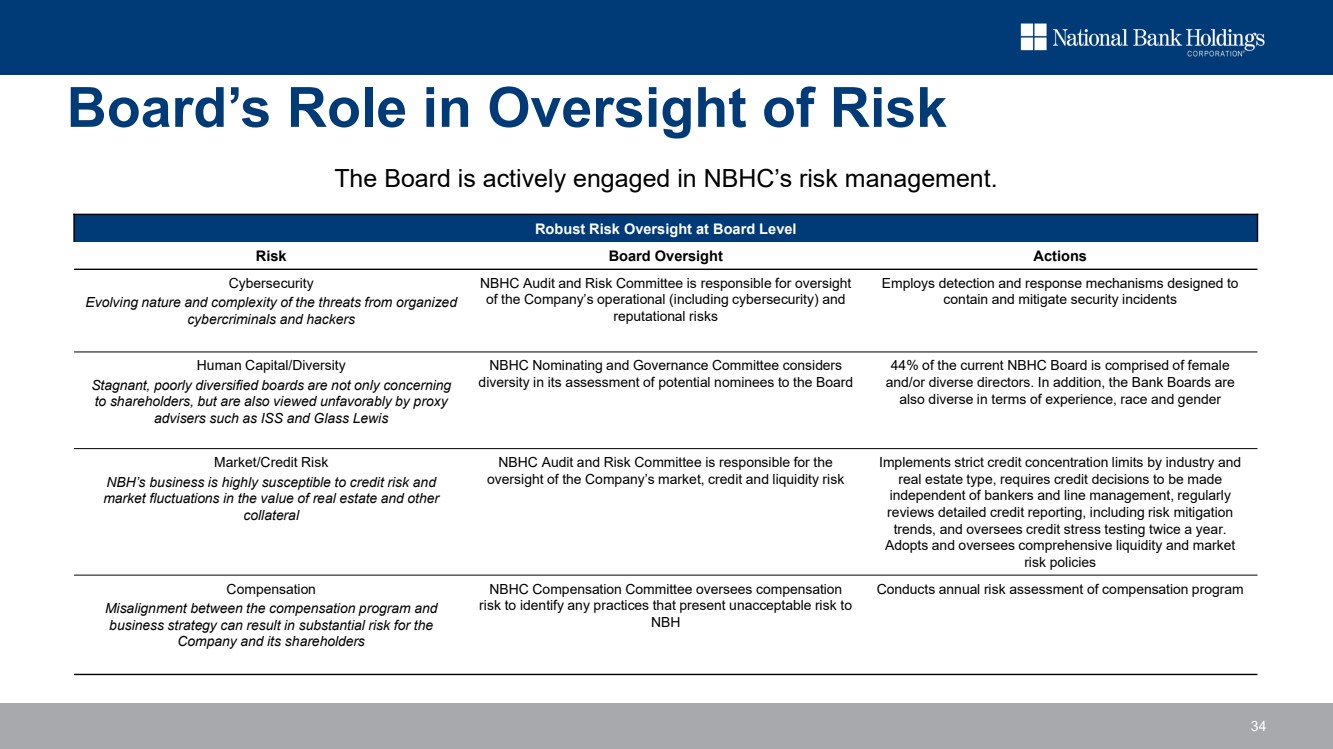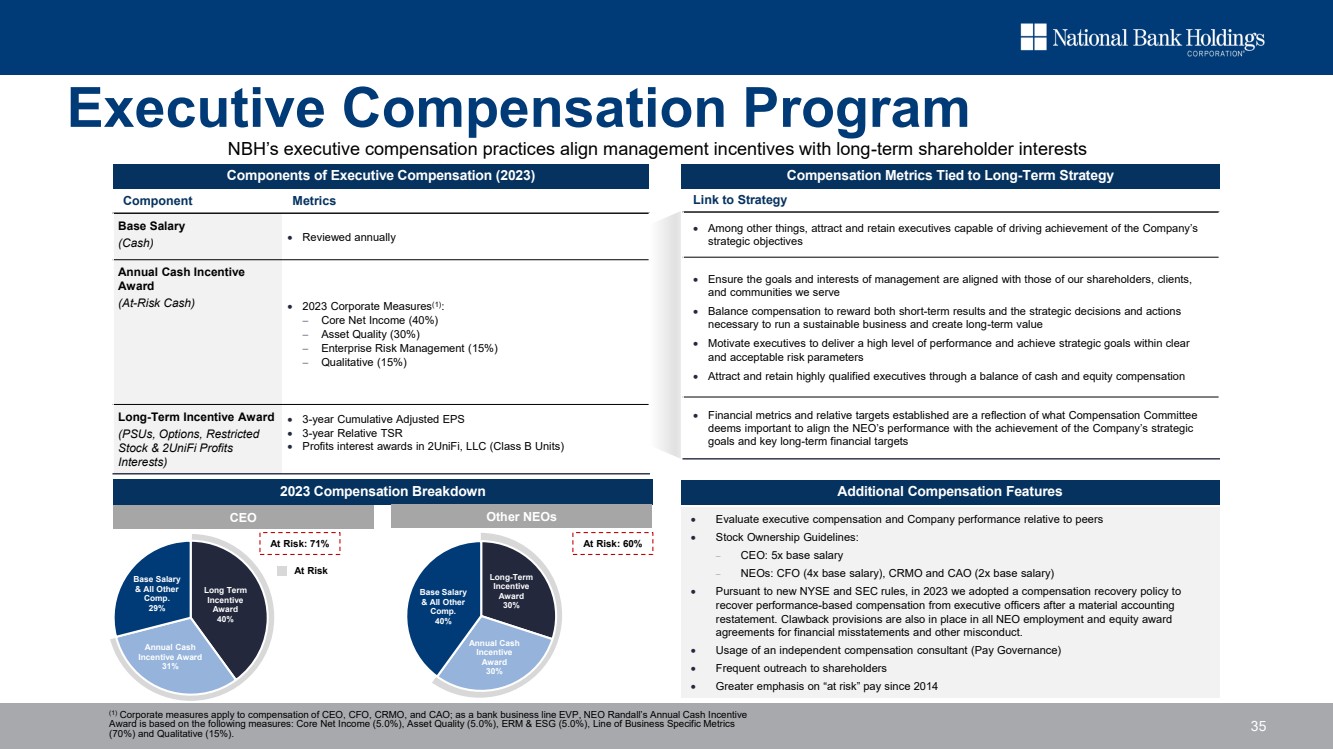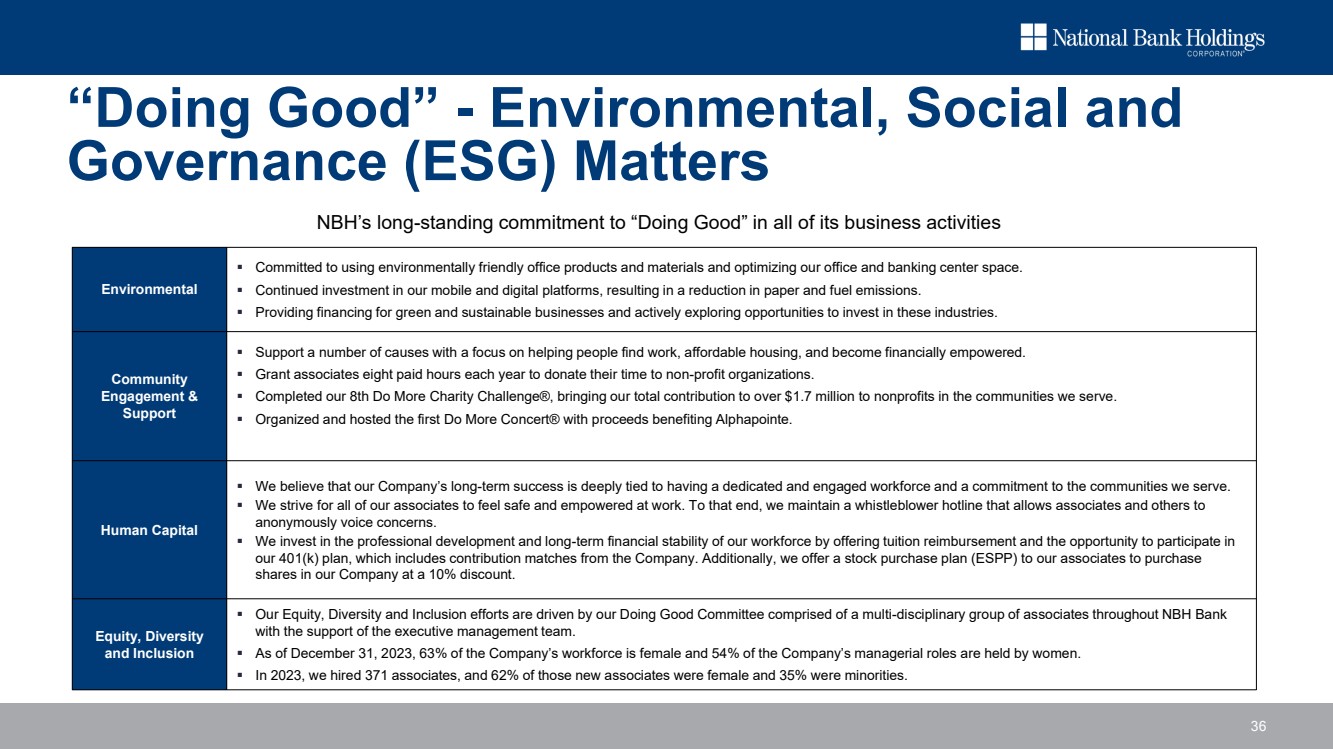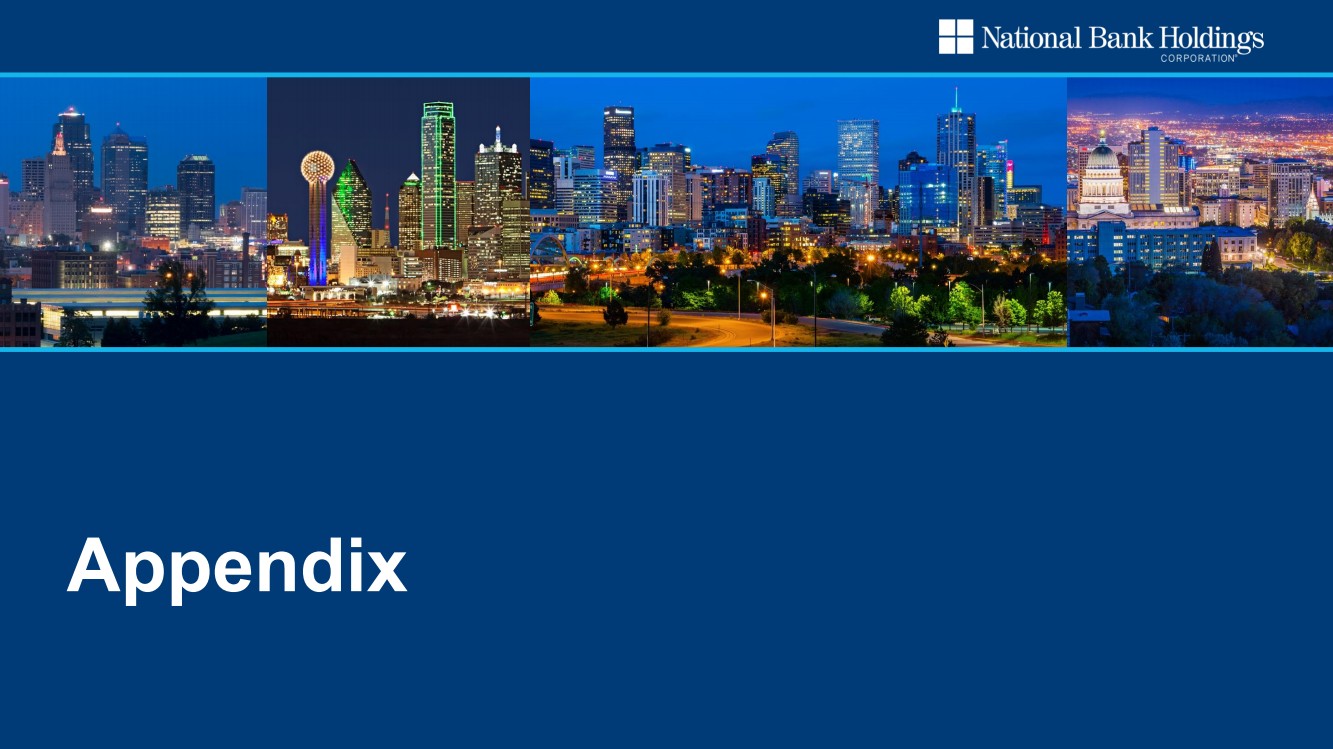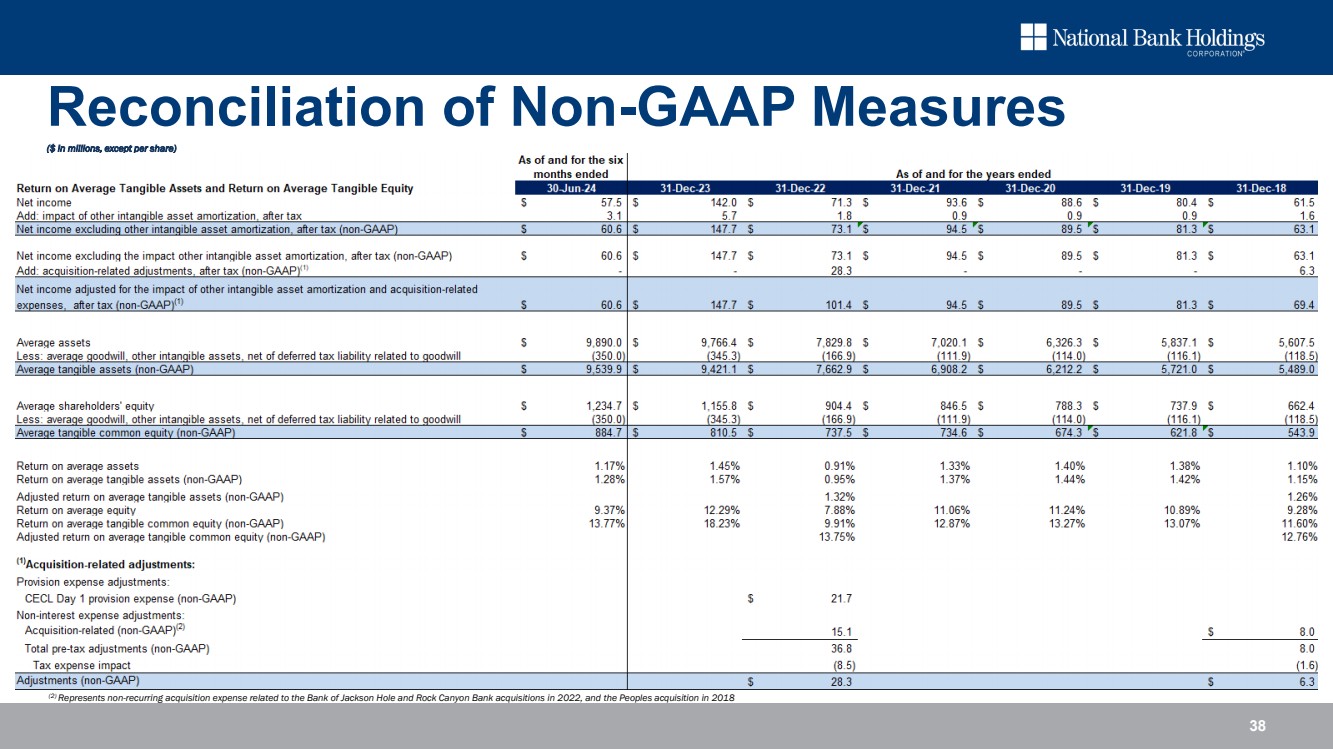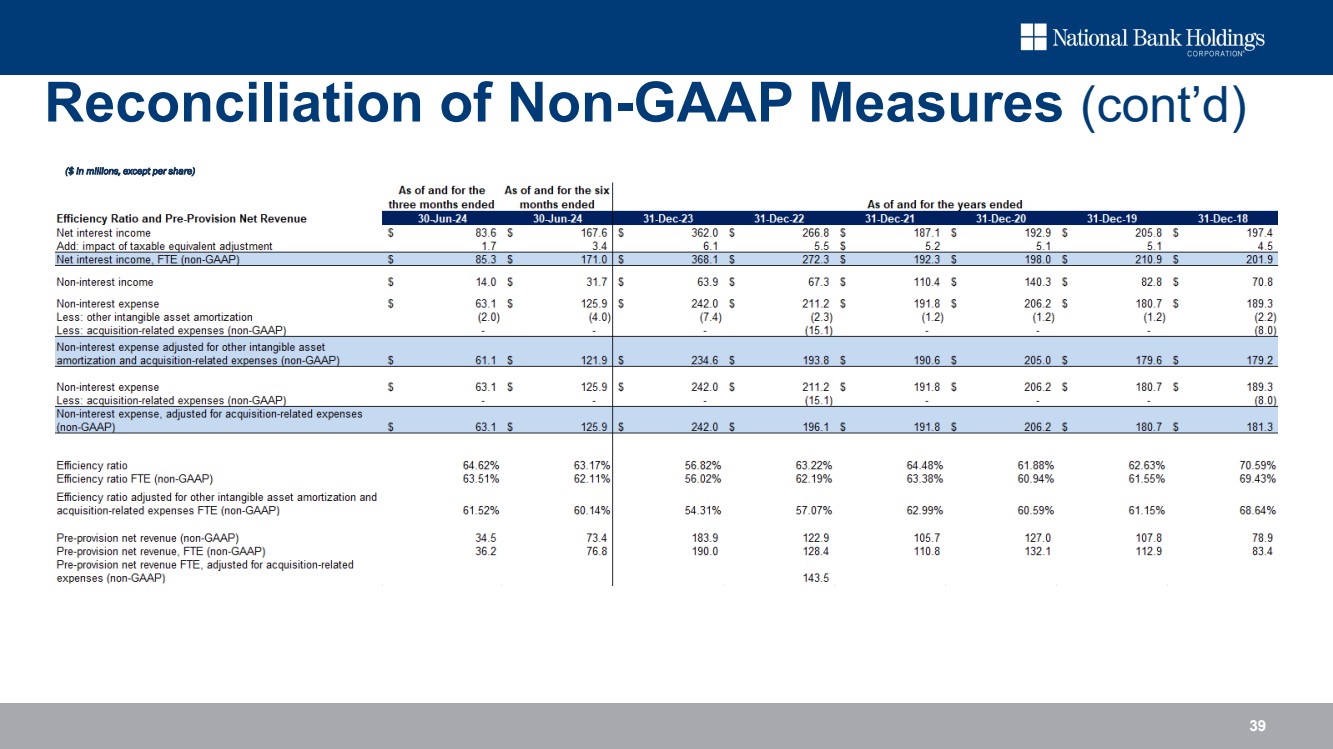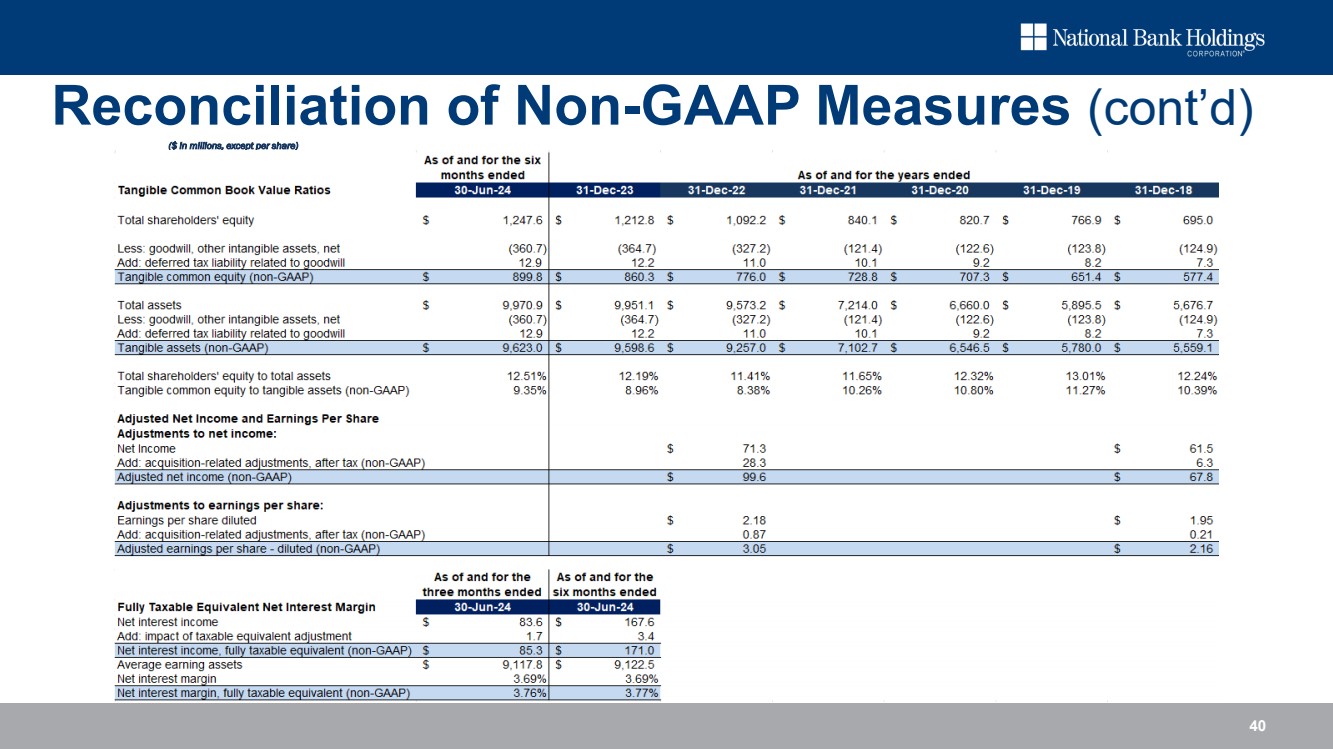| Investor Presentation Q2 – 2024 |
| Forward-Looking Statements This presentation contains “forward-looking statements” within the meaning of the Private Securities Litigation Reform Act of 1995. Forward-looking statements contain words such as “anticipate,” “believe,” “can,” “would,” “should,” “could,” “may,” “predict,” “seek,” “potential,” “will,” “estimate,” “target,” “plan,” “project,” “continuing,” “ongoing,” “expect,” “intend” or similar expressions that relate to the Company’s strategy, plans or intentions. Forward-looking statements involve certain important risks, uncertainties and other factors, any of which could cause actual results to differ materially from those in such statements. Such factors include, without limitation, the “Risk Factors” referenced in our most recent Form 10-K filed with the Securities and Exchange Commission (SEC), other risks and uncertainties listed from time to time in our reports and documents filed with the SEC, and the following factors: the impact of potential regulatory changes to capital requirements, treatment of investment securities and FDIC deposit insurance levels and costs; our ability to execute our business strategy, including our digital strategy, as well as changes in our business strategy or development plans; business and economic conditions; effects of any potential government shutdowns; economic, market, operational, liquidity, credit and interest rate risks associated with the Company’s business, including increased competition for deposits due to prevailing market interest rates and banking sector volatility; effects of any changes in trade, monetary and fiscal policies and laws, including the interest rate policies of the Federal Reserve Board; changes imposed by regulatory agencies to increase capital standards; effects of inflation, as well as interest rate, securities market and monetary supply fluctuations; changes in the economy or supply-demand imbalances affecting local real estate values; changes in consumer spending, borrowings and savings habits; changes in the fair value of our investment securities due to market conditions outside of our control; financial or reputational impacts associated with the increased prevalence of fraud or other financial crimes; with respect to our mortgage business, the inability to negotiate fees with investors for the purchase of our loans or our obligation to indemnify purchasers or repurchase related loans if the loans fail to meet certain criteria, or higher rate of delinquencies and defaults as a result of the geographic concentration of our servicing portfolio; the Company’s ability to identify potential candidates for, obtain regulatory approval for, and consummate, integrate and realize operating efficiencies from, acquisitions, consolidations and other expansion opportunities; our ability to integrate acquisitions or consolidations and to achieve synergies, operating efficiencies and/or other expected benefits within expected time-frames, or at all, or within expected cost projections, and to preserve the goodwill of acquired financial institutions; the Company's ability to realize anticipated benefits from enhancements or updates to its core operating systems from time to time without significant change in client service or risk to the Company's control environment; the Company's dependence on information technology and telecommunications systems of third-party service providers and the risk of systems failures, interruptions or breaches of security, including those that could result in disclosure or misuse of confidential or proprietary client or other information; the Company’s ability to achieve organic loan and deposit growth and the competition for, and composition of, such growth; changes in sources and uses of funds; increased competition in the financial services industry; regulatory and financial impacts associated with the Company growing to over $10 billion in consolidated assets; increases in claims and litigation related to our fiduciary responsibilities in connection with our trust and wealth management business; the effect of changes in accounting policies and practices as may be adopted by the regulatory agencies, as well as the Public Company Accounting Oversight Board, the Financial Accounting Standards Board (“FASB”) and other accounting standard setters; the share price of the Company’s stock; the Company's ability to realize deferred tax assets or the need for a valuation allowance, or the effects of changes in tax laws on our deferred tax assets; the effects of tax legislation, including the potential of future increases to prevailing tax rules, or challenges to our positions; continued consolidation in the financial services industry; ability to maintain or increase market share and control expenses; costs and effects of changes in laws and regulations and of other legal and regulatory developments, including, but not limited to, changes in regulation that affect the fees that we charge, the resolution of legal proceedings or regulatory or other government inquiries, and the results of regulatory examinations, reviews or other inquiries, and changes in regulations that apply to us as a Colorado state-chartered bank and a Wyoming state-chartered bank; technological changes, including with respect to the advancement of artificial intelligence; the timely development and acceptance of new products and services, including in the digital technology space our digital solution 2UniFi; changes in our management personnel and the Company’s continued ability to attract, hire and maintain qualified personnel; ability to implement and/or improve operational management and other internal risk controls and processes and reporting system and procedures; regulatory limitations on dividends from our bank subsidiaries; changes in estimates of future credit reserve requirements based upon the periodic review thereof under relevant regulatory and accounting requirements; financial, reputational, or strategic risks associated with our investments in financial technology companies and initiatives; widespread natural and other disasters, pandemics, dislocations, political instability, acts of war or terrorist activities, cyberattacks or international hostilities through impacts on the economy and financial markets generally or on us or our counterparties specifically; a cybersecurity incident, data breach or a failure of a key information technology system; impact of reputational risk; other risks and uncertainties listed from time to time in the Company’s reports and documents filed with the Securities and Exchange Commission; and success at managing the risks involved in the foregoing items. The Company can give no assurance that any goal or plan or expectation set forth in forward-looking statements can be achieved and readers are cautioned not to place undue reliance on such statements. The forward-looking statements are made as of the date of this presentation, and the Company does not intend, and assumes no obligation, to update any forward-looking statement to reflect events or circumstances after the date on which the statement is made or to reflect the occurrence of unanticipated events or circumstances, except as required by applicable law. Further Information: This presentation should be read together with “Management’s Discussion and Analysis of Financial Condition and Results of Operations” and the consolidated financial statements and the related notes thereto included in our Form 10-K and quarterly reports 2 |
| About Non-GAAP Financial Measures Certain of the financial measures and ratios we present, including “tangible assets,” “average tangible assets,” “return on average tangible assets,” “tangible common equity,” “average tangible common equity,” “return on average tangible common equity,” “tangible common equity to tangible assets,” “loan marks/total loans,” “total loan loss coverage including loan marks,” “net interest income, FTE,” “net interest margin, FTE,” “adjusted non-interest expense,” “non-interest expense adjusted for other intangible asset amortization and acquisition-related expenses,” “non-interest expense, adjusted for acquisition-related expenses,” “efficiency ratio FTE,” “efficiency ratio adjusted for other intangible asset amortization and acquisition-related expenses FTE,” “adjusted net income,” “adjusted earnings per share – diluted,” “net income adjusted for the impact of other intangible asset amortization expense and acquisition-related expenses, after tax,” “net income excluding other intangible asset amortization, after tax,” “net income excluding the impact other intangible asset amortization, after tax,” “adjusted return on average tangible assets,” “adjusted return on average tangible common equity,” “pre-provision net revenue,” “pre-provision net revenue, FTE,” and “pre-provision net revenue FTE, adjusted for acquisition-related expenses,” are supplemental measures that are not required by, nor presented in accordance with, U.S. generally accepted accounting principles (GAAP). We refer to these financial measures and ratios as “non-GAAP financial measures.” We consider the use of select non-GAAP financial measures and ratios to be useful for financial and operational decision making and useful in evaluating period-to-period comparisons. We believe that these non-GAAP financial measures provide meaningful supplemental information regarding our performance by excluding certain expenditures or assets that we believe are not indicative of our primary business operating results or by presenting certain metrics on a fully taxable equivalent basis. We believe that management and investors benefit from referring to these non-GAAP financial measures in assessing our performance and when planning, forecasting, analyzing and comparing past, present and future periods. These non-GAAP financial measures should not be considered a substitute for financial information presented in accordance with GAAP and you should not rely on non-GAAP financial measures alone as measures of our performance. The non-GAAP financial measures we present may differ from non-GAAP financial measures used by our peers or other companies. We compensate for these limitations by providing the equivalent GAAP measures whenever we present the non-GAAP financial measures and by including a reconciliation of the impact of the components adjusted for in the non-GAAP financial measure so that both measures and the individual components may be considered when analyzing our performance. A reconciliation of non-GAAP financial measures to the comparable GAAP financial measures is included in the appendix. 3 |
| Table of Contents Financial Performance 07 Credit 13 Balance Sheet 18 2UniFi 23 Cambr 25 Management Team 27 Corporate Governance 30 Appendix 37 |
| (1)As of June 30, 2024. Includes one banking center shared by NBH Bank and BOJH Trust. (2)Represents a non-GAAP financial measure. ROAA and ROAE totaled 1.17% and 9.37% respectively. See Appendix for a reconciliation of these measures. (3)Excluding other intangible asset amortization Attractive Markets Company Highlights Headquarters Denver, CO Banking Centers(1) 94 Listing NYSE: NBHC 37 banking centers ‒#1 in Hottest U.S. Housing Markets (U.S. News 2024) ‒#3 Colorado Springs and #10 Boulder in Best Places to Live (U.S. News 2024) ‒#4 Best Economy in the U.S. (U.S. News 2024) ‒#7 in Best States to Start a Business (WalletHub 2024) 14 banking centers across Utah, New Mexico, and Idaho 2 commercial banking locations in Texas ‒Utah: #1 in Best States to Start a Business (WalletHub 2024) ‒Idaho: #2 Best Economy in the U.S. (U.S. News 2024) ‒Utah: #3 Best Economy in the U.S. (U.S. News 2024) ‒Texas: #6 Best Economy in the U.S. (U.S. News 2024) 32 banking centers ‒Overland Park, KS - central hub for the #1 county in Kansas by household income and projected population growth(1) ‒Overland Park, KS #7 on Top 100 Best Places to Live (Livability 2024) ‒Kansas City, MO #7 Hottest Housing Markets (Zillow 2023) ‒Kansas City, MO #9 Best Markets for First-Time Homebuyers (Zillow 2024) (1)Ranking based on aggregate population growth for 2021-2026 (2)Includes one banking center shared by NBH Bank and BOJH Trust Balance Sheet 2Q24 Total Assets (mm) $9,971 Total Loans (mm) $7,722 Total Deposits (mm) $8,377 Key Ratios YTD24 Common Equity Tier 1 12.41% Tier 1 Leverage 10.20% ROATA(2) 1.28% ROATCE(2) 13.77% Net Interest Margin FTE(2) 3.77% ACL / Loans 1.25% Efficiency Ratio FTE(2)(3) 60.14% 9 banking centers(2) ‒Wyoming: #1 in State Business Tax Climate Index (Tax Foundation 2023) ‒Wyoming: #1 Tax Friendly state for middle income families (Kiplinger 2023) 5 |
| (20%) (15%) (10%) (5%) 0% 5% 10% 15% 20% 25% Baseline NBH Outperformance $0.75 $0.80 $0.87 $0.94 $1.04 $0.55 2019 2020 2021 2022 2023 YTD24 Shareholder Returns Source: S&P Global Market Intelligence, FactSet Research Systems, Bloomberg; market data as of 6/30/2024 (1)Peer median of the following group of 58 regional banks included in the S&P Small Cap 600 Index, not including NBHC: ABCB, AUB, AX, BANC, BANF, BANR, BHLB, BKU, BOH, BRKL, CASH, CATY, CBU, CFFN, CHCO, CPF, CUBI, CVBF, DCOM, EGBN, FBK, FBNC, FBP, FCF, FFBC, FHB, FULT, HAFC, HFWA, HOPE, HTH, IBTX, INDB, LKFN, NBTB, NWBI, OFG, PFBC, PFS, PPBI, PRK, RNST, SBCF, SBSI, SFBS, SFNC, STBA, STEL, TBBK, TFIN, TMP, TRMK, TRST, UCBI, VBTX, WABC, WAFD, WSFS (2)Represents a non-GAAP financial measure. See Appendix for a reconciliation of these measures. 5-year Performance of NBH Shareholder Returns vs. S&P 600 Regional Banks(1) Historical Dividend Per Share Dividend Payout Ratio Target 30 - 40% of core earnings CAGR: 9% 22.3% $80.4 $88.6 $93.6 $28.3 $142.0 $57.5 YE19 YE20 YE21 YE22 YE23 YTD24 Net Income Non-Adjusted Adjusted ($ in millions) $99.6 $71.3 (2) 6 |
| Financial Performance |
| Deposits Approximately 79% FDIC insured deposits Capital Ratios 12.4% Common Equity Tier 1 Ratio Q2 2024 Financial Highlights (1)Represents a non-GAAP financial measure. See Appendix for a reconciliation of these measures. (2)Excluding other intangible asset amortization Quarterly net income of $26.1 million, or $0.68 per diluted share The fully taxable equivalent net interest margin was 3.76% Strong capital with tangible common equity to tangible assets ratio of 9.35% and tier 1 leverage ratio of 10.20% Cash/investment securities portfolio with an average duration of 4.0 years Total loans increased $153.1 million, or 8.1% annualized, to $7.7 billion from 1Q24 Generated quarterly loan fundings totaling $505.2 million with a weighted average new loan origination rate of 8.4% Average total deposits increased $160.9 million, or 7.9% annualized, to $8.4 billion from 1Q24 Non-performing loans decreased 13 basis points to 0.34% of total loans from 1Q24 Expense 61.5% efficiency ratio FTE(1)(2) ACL / Loans 1.25% Loans Loans outstanding of $7.7 billion Net Income $26.1 million 3.76% Net interest margin FTE(1) 8 |
| Profitable Steady Growth $80.4 $88.6 $93.6 $28.3 $142.0 $57.5 YE18 YE19 YE20 YE21 YE22 YE23 YTD24 Net Income Non-Adjusted Adjusted $2.55 $2.85 $3.01 $0.87 $3.72 $1.50 YE18 YE19 YE20 YE21 YE22 YE23 YTD24 EPS (Fully Diluted) Non-Adjusted Adjusted ($ in millions) 1.15% 1.42% 1.44% 1.37% 0.95% 1.57% 1.26% 1.32% 1.28% YE18 YE19 YE20 YE21 YE22 YE23 YTD24 ROATA(1) Non-Adjusted Adjusted 69.4% 61.6% 60.9% 63.4% 62.2% 56.0% 63.2% 68.6% 61.1% 60.6% 63.0% 57.1% 54.3% 60.1% YE18 YE19 YE20 YE21 YE22 YE23 YTD24 Efficiency Ratio FTE(1) Non-Adjusted Excluding other intangible asset amortization $83.4 $112.9 $132.1 $110.8 $143.5 $190.0 $76.8 YE18 YE19 YE20 YE21 YE22 YE23 YTD24 Pre-Provision Net Revenue FTE(1) ($ in millions) 11.60% 13.07% 13.27% 12.87% 9.91% 18.23% 13.77% 12.76% 13.75% YE18 YE19 YE20 YE21 YE22 YE23 YTD24 ROATCE(1) Non-Adjusted Adjusted $61.5 $67.8 (1) $2.16 $1.95 $0.21 (1) (1) (1)Represents a non-GAAP financial measure. See Appendix for a reconciliation of these measures. (1) (1) (1) $6.3 $3.05 $2.18 (1) $71.3 $99.6 (1) $128.4 $15.1 (1) 9 |
| Growth Trends $5.7 $5.9 $6.7 $7.2 $9.6 $9.9 $9.9 YE18 YE19 YE20 YE21 YE22 YE23 YTD24 Total Assets $4.1 $4.4 $4.2 $4.5 $7.2 $7.7 $7.7 $0.2 YE18 YE19 YE20 YE21 YE22 YE23 YTD24 Total Loans Non-PPP Loans PPP Loans $577.4 $651.4 $707.3 $728.8 $776.0 $860.3 $899.8 YE18 YE19 YE20 YE21 YE22 YE23 YTD24 ($ in billions) ($ in billions) ($ in millions) Tangible Common Equity(3) (1) Includes $2.3 billion of total assets added through the Rock Canyon Bank and Bank of Jackson Hole acquisitions in 2022. (2)Includes $1.7 billion of loans added through the Rock Canyon Bank and Bank of Jackson Hole acquisitions in 2022. (3)Represents a non-GAAP financial measure. See Appendix for a reconciliation of these measures. $4.4 (2) (1) 10 |
| Trust and Wealth Partners Trust and Wealth Management solution tailored to high net worth individuals Scalable Private Wealth team provides a broad range of financial and retirement planning solutions, creating an opportunity to further leverage the platform to new and existing NBH clients Established relationships with strong investment and research partners drives ability to cross-sell Fee income drives revenue diversification and attractive recurring earnings 450+ High Net Worth Clients $920mm+ AUM 11 |
| Prudent Stewards of Capital TIER 1 LEVERAGE 10.20% COMMON EQUITY TIER 1 RISK-BASED 12.41% TIER 1 RISK-BASED 12.41% TOTAL RISK-BASED 14.32% TANGIBLE COMMON EQUITY TO TANGIBLE ASSETS(1) 9.35% Capital Ratios – YTD24 (1)Represents a non-GAAP financial measure. See Appendix for a reconciliation of these measures. (2)Peer median includes the following group of 55 regional banks that have reported ROATCE YTD24 results from the group of 58 regional banks included in the S&P 600 Regional Banks Index, not including NBHC: ABCB, AUB, BANC, BANF, BANR, BHLB, BKU, BOH, BRKL, CASH, CATY, CBU, CFFN, CHCO, CUBI, CVBF, DCOM, EGBN, FBK, FBNC, FBP, FCF, FFBC, FHB, FULT, HFWA, HOPE, HTH, IBTX, INDB, LKFN, NBTB, NWBI, OFG, PFBC, PFS, PPBI, PRK, RNST, SBCF, SBSI, SFBS, SFNC, STBA, STEL, TBBK, TFIN, TMP, TRMK, TRST, UCB, VBTX, WABC, WAFD, WSFS, as reported via S&P Global Market Intelligence through August 15, 2024. $429 million in excess capital over 7.0% common equity tier 1 risk-based regulatory requirement Double-leverage ratio of 92.2% $50 million authorized for current share repurchase program Holding company cash reserves of $100 million sufficient to support shareholder dividend payments High quality capital stack 12 NBHC 13.77% PEER MEDIAN(2) 12.20% ROATCE(1) – YTD24 |
| Credit |
| Uniquely Diversified $7.7 Billion Loan Portfolio Concentrations Self-imposed concentration limits ensure a granular and diverse loan portfolio and protect against downside risk to any particular industry or real estate sector Individual industry sectors are limited to no more than 15% of total loan commitments, with the majority being 10% or less Non-owner occupied CRE is 165% of risk-based capital and no specific property type exceeds 6% New commercial loans originated YTD: - Average funding of $1.3 million - Weighted average commitment, including unused, of $1.8 million Residential loans originated YTD: - Average funding of $466 thousand - Average FICO of 768 - Average LTV of 73% Top 25 originated relationships as of June 2024: - Average funded balance of $22 million - Average commitment of $31 million Granular and Well-Diversified Loan Portfolio 3% 4% Residential 17% Non-owner occupied CRE 24% C&I 44% and Owner-occupied CRE 15% 14 6% 5% 3% 3% 2% 1% 4% 15% 1% 10% 1% 7% 5% 4% 3% 3% 3% 3% 2% 2% 1%1% 1% 1% 13% C&I, 44% and Owner-occupied CRE , 15% Non-owner occupied CRE, 24% Government & Municipal, 10% Hotel & Lodging, 6% Equipment Leasing, 7% Multifamily, 5% Restaurant, 5% Commercial Construction, 3% Educational Services, 4% Land Development, 3% Transportation & Warehousing, 3% Warehouse & Industrial, 2% Agribusiness, 3% Office, 1% Manufacturing, 3% All Other, 4% Retail Trade, 3% Materials & Construction Companies, 2% Residential, 17% Real Estate Rental & Leasing, 2% Residential Sr. Lien, 15% Wholesale Trade, 1% Residential Jr. Lien, 1% Financial Services, 1% Other, 1% Food and Other, 1% Lender Finance, 1% All Other C&I, 13% |
| Granular CRE Portfolio Hotel & Lodging 24% Multifamily 19% CML Const. 13% Retail 8% Warehouse & Ind. 9% All Other 7% CML A & D 4% Office 6% Nursing Home 4% 1-4 Family Const. 6% Office: - Average LTV of 47.7% - 1.4% of total loans Retail: - Average LTV of 59.3% - 2.1% of total loans Multi-Family: - Average LTV of 49.4% - 4.6% of total loans Non-owner occupied CRE(1) Non-owner occupied CRE Portfolio Characteristics 15 (1)Percentages are as a total of the non-owner occupied CRE portfolio. |
| Strong Credit Quality History YE21 YE22 YE23 YTD24 Loan charge-offs 0.16% 0.17% 0.34% 0.29% 0.09% 0.06% 0.03% 0.15% 0.05% 0.05% 0.05% 0.02% YE21* YE22 YE23 2Q24 Non-performing loans Acquired non-performing loans OREO Non-performing Loans Non-performing Asset Composition Net Charge-Offs(1) Total Classified Loans 0.40%* (1)As a % of average total loans $11 $17 $28 $26 0.24% 0.23% 0.37% 0.34% YE21 YE22 YE23 2Q24 Non-performing loans Non-performing loans as a % of total loans 0.03% 0.28% * Excludes PPP loans. 0.42% 0.03% ($ in millions) 0.02% 0.36% $29 $23 $52 $53 0.7% 0.6% 0.7% 0.9% YE21 YE22 YE23 2Q24 Classified loans % of total loans $17 $70 $17 $40 Acquired loans $16 $68 0.11% 16 |
| Credit Loss Protection $96.5 Total Loan Loss Coverage Including Loan Marks 1.58%(1) ACL/Total Loans 1.25% Loan Marks/Total Loans 0.33%(1) $25.4 $121.9 All dollars in millions (1)Represents a non-GAAP financial measure ACL 6/30/2024 Loan Marks 6/30/2024 TOTAL 6/30/2024 17 |
| Balance Sheet |
| Portfolio built on a relationship-banking strategy, with emphasis on depository and treasury management relationships Self-imposed concentration limits; individual industry sectors are limited to no more than 15% of total loan commitments, with the majority being 10% or less Industries requiring in-depth knowledge are managed by specialty banking teams, with dedicated specialist underwriters New loan fundings over the trailing twelve months totaled $1.5 billion, led by commercial loan fundings of $1.0 billion Generated quarterly loan fundings totaling $505.2 million with a weighted average new loan origination rate of 8.4% FY18 FY19 FY20 FY21 FY22 FY23 2Q24 $1.5 (TTM) (1)Excludes loans held-for-sale $1.2 $1.2 $1.2 $1.5 Owner-Occupied CRE 15% Non-Owner Occupied CRE 24% Resi Mortgage & Consumer 17% C & I 44% Loan Composition ($7.7 Billion) Quarterly Loan Fundings ($ in millions) Total Loan Fundings(1) ($ in billions) Solid Loan Growth $362.3 $324.1 $460.4 $200.0 $505.2 2Q23 3Q23 4Q23 1Q24 2Q24 $2.0 TTM: Trailing Twelve Months $1.5 19 |
| 4.1% 10.1% 0.2% 85.6% Cash U.S. Treasury Other U.S. Agency Mortgage/Sponsored Debt High Quality Liquidity Portfolio: $1.2 Billion Liquidity portfolio duration of 4.0 years Portfolio used exclusively as an on-balance sheet source of liquidity: 42% unencumbered 58% pledged directly to client deposits or repo No credit risk exists given 99.8% of investment portfolio is U.S. agency/sponsored agency and U.S. Treasury backed $1.2 Billion Liquidity Portfolio(1) (1)Represents market value as of June 30, 2024, regardless of AFS/HTM designation. Excludes investments made under equity accounting method. 20 |
| Granular Deposit Base No exposure to venture capital or crypto deposits Average total deposits increased $160.9 million, or 7.9% annualized, to $8.4 billion during 2Q24 Average total deposits increased $469.1 million, or 6.0%, to $8.3 billion over YTD23 The mix of transaction deposits to total deposits was 87.8% Low Cost Deposits ($ in billions) $5.1 $5.9 $7.0 $7.3 $0.9 $0.8 $1.0 $1.0 YE21 YE22 YE23 YTD24 Average Transaction Deposits Average Time Deposits 50% 51% 47% 44% 37% 37% 41% 44% 11% 9% 8% 9% 2% 3% 4% 3% $6.2 $7.9 $8.2 $8.4 0% 50% 100% YE21 YE22 YE23 YTD24 Demand & NOW Savings & MM CDs < $250k CDs >= $250k Total 87% Non-Time 88% Non-Time 88% Non-Time 88% Non-Time 0.25% 4.50% 5.50% 5.50% 0.12% 0.26% 1.26% 2.10% 0.23% 0.33% 1.37% 2.23% FY21 FY22 FY23 YTD24 Fed Funds rate Cost of transaction deposits Cost of deposits Low Cost Transaction Deposits Growing Low Cost Transaction Accounts Deposit Composition 21 |
| Relationship Focused Deposit Base: $8.4 Billion Approximately 79% FDIC insured Granular deposit base: - Average deposit balance on full relationship basis just $50 thousand - Average deposit per account $26 thousand Approximately $0.5 billion of deposits collateralized No concentrations to any industry, sector or geography No venture capital or crypto deposits 3% Deposit Composition4% Time Deposits 12% Savings & Money Market Deposits 44% Non-interest bearing DDA 27% Interest bearing DDA Transaction 17% Accounts 44% 22 |
| 2UniFi |
| Financial Capital Social Capital Technical Capital Cultural Capital Operational Efficiency FDIC insured acct., protected deposits, treasury management, recurring billing, invoicing Improved operating information, financial statement preparation, marketplace opportunities Cash Flow Analysis, predictive analytics, personalization Budgeting & Growth Planning Goals, savings, needs by phase, access to growth vehicles, credit, growth projections, growth tracking Financial Management Data Insights & Reporting Fraud protection, faster and lower cost payment processing, B2B payments Digital Security Mentorship & Guidance Dedicated mentors, situational mentorship, crowdsourced information, referrals Connect businesses, partner linking, partnership formation, collective support, business collaborations Community of Support Verified network, direct value connections, affinity groups Partnership & Collaboration Fair Access Reduce bias in lending, get equal access to relevant advice and capital needs User needs validation, bring users into the process, user testing, bias and assumption reduction User Alignment & Buy-in Education and guidance, day-to-day activity decision-making, strategic planning Education & Financial Literacy Easier access to trade finance / working capital and SBA loans Digital Lending 2UniFi: an innovation platform that builds 'capital' and drives outcomes for SMBs. 24 |
| Cambr |
| Strategic Rationale Cambr is a deposit acquisition and processing platform that is designed to (i) service banks (“Banks of Record”) in recordkeeping for core deposits received via exclusive relationships with embedded finance companies and (ii) allocate customer deposits in excess of FDIC insurance to other insured depository institutions to maximize insurance for customers. Cambr has relationships with leading embedded finance companies and their partner banks to provide them these deposit services. Cambr allocates these deposits to a network of banks. Cambr generates revenue through a revenue share based on the interest income derived from the bank network. About Cambr Relationship Schematic Diversifies NBH’s Deposit Franchise with Minimal Overhead Costs End User Bank of Record NBH Custodial Account Cambr Deposit Network $ $ $ Embedded Finance Program Data Deposit Flows Account Details & Instructions Funding Flexibility: Certain relationships with Banks of Record enable NBH to keep deposits or “push” them to the bank network as needed Manage liquidity Manage capital (leverage ratio) Minimal Overhead: The Cambr platform is primarily fixed expense base with minimal variable expenses Competitive Hedge: Benefit from ongoing embedded finance competition and disruption in the banking industry Income Diversification: Cambr income is not tied to NBH balance sheet growth Multitude of Use Cases: Cambr’s technology can support deposit management for a broad range of business segments Cambr Overview 26 |
| Management Team |
| Experienced Management Team Nicole Van Denabeele EVP, Chief Accounting Officer • 20+ years of financial services experience • Controller at Polsinelli, PC • Senior Vice President, Assistant Controller at UMB Financial Corporation • Started career in public accounting at Deloitte, LLP Christopher Randall EVP, Commercial, Specialty and Business Banking • 25+ years of banking experience • Previously Senior Managing Director, Specialty Banking since 2013 • Director and Founder of CoBiz Structured Finance • Executive of Marquette Financial Companies Brendan Zahl EVP, Personal, Private and Residential Banking • 20+ years of banking experience • Retail, Commercial Deposit and Lending Management at Peoples National Bank; served as Peoples National Bank CEO from 2012-2017 • Progressive leadership growth during 10-year tenure at FirstBank Tim Laney Chairman, President & CEO (43 years in banking) • Head of Business Services at Regions Financial, where he also led the transformation of wholesale lines of business • Senior management roles in small business, commercial banking, private banking, corporate marketing and change management and Management Operating Committee member at Bank of America; also served as President, Bank of America, Florida Richard Newfield Chief Risk Management Officer (40 years in banking) • Head of Business Services Credit at Regions Financial • Senior roles in risk management, credit, commercial banking, global bank debt and corporate marketing at Bank of America Aldis Birkans Chief Financial Officer (26 years in financial industry) • Senior Vice President, Treasurer at NBHC • Vice President, Assistant Treasurer at M&I Bank • Senior Vice President, Corporate and Investment Bank Treasury at Citigroup Angela Petrucci Chief Administrative Officer & General Counsel (23 years in legal and banking) • Senior Vice President, General Counsel at NBH Bank • In House Counsel at Accenture and an associate at Chapman and Cutler LLP • Started career as a commercial banker at First Chicago Bank (now JP Morgan Chase) Valerie Kramer EVP, Chief Digital Officer • 20+ years of financial services experience • Served in multiple Treasury Management and Client Solution roles with NBH Bank, including Treasury Management Director, over a 13 year period 28 |
| Management & Directors NBHC MANAGEMENT & DIRECTORS BENEFICIAL OWNERSHIP(1) PERCENT OF CLASS(2) G. Timothy Laney 521,139 1.36% Aldis Birkans 91,942 0.24% Richard U. Newfield, Jr. 199,929 0.52% Angela Petrucci 32,428 0.08% Ralph W. Clermont 93,349 0.24% Robert E. Dean 34,814 0.09% Robin A. Doyle 4,030 0.01% Alka Gupta 9,528 0.02% Fred J. Joseph 24,028 0.06% Patrick Sobers 39,526 0.10% Micho F. Spring 41,050 0.11% Art Zeile 20,077 0.05% All current NBHC management and directors as a group (15 persons) 1,247,622 3.24% Beneficial Ownership (as of 6/30/24) (1) Includes unvested restricted shares for which the director or officer has voting power and shares issuable upon the exercise of options as well as indirect ownership. Does not include unvested performance stock units. (2) Calculated in accordance with Item 403 of Regulation S-K, and based on 37,899,543 shares of Class A common stock outstanding and entitled to vote and 319,292 shares of unvested restricted stock entitled to vote. 29 |
| Corporate Governance |
| Best Practices In Governance and Compensation Corporate Governance Lead Independent Director with robust role and responsibilities Majority independent Board No short-selling, hedging, or pledging of NBHC shares (applies to all NBHC and NBH Bank insiders) Annual election of Board members and say-on-pay vote Fully independent Audit & Risk, Compensation, and Nominating & Governance Committees Annual Director and Committee evaluation process Board-adopted Code of Conduct that applies to all directors, officers, and employees Published Corporate Governance Guidelines Executive Compensation Provide the majority of compensation in the form of variable, performance-based elements Ensure a strong link between financial and operational goals, shareholder value creation, and executive compensation Conduct shareholder engagement on compensation- and governance-related issues, and respond to shareholder feedback as appropriate Enforce stock ownership guidelines for executives (5x base salary for CEO and 4x/2x base salary for other NEOs) and non-employee directors (5x annual Board cash retainer) Provide a clawback policy for recoupment of incentive compensation in the event of a material restatement of financial or operating results Impose a double-trigger change-in-control requirement before vesting of outstanding, unvested equity awards is accelerated Use an independent compensation consultant Conduct annual risk assessment of compensation program Conduct annual say-on-pay vote NBHC’s corporate governance policies and executive compensation practices support our business and align with best practices 31 |
| Fred J. Joseph Financial services regulator for 30 years as the Banking and Securities Commissioner for the State of Colorado Member of the Investor Issues Committee for FINRA A N I Compensation Independent Governance & Nominating Committee Chair Audit & Risk Appointed within the last five years G. Timothy Laney President, CEO and Chairman Former Sr Executive VP & Head of Business Services at Regions Financial 24-year tenure at Bank of America, and a member of Bank of America’s Management Operating Committee C N * I Robust Lead Director Responsibilities Mr. Clermont presides at all Board meetings where the Chairman is not present and at all executive sessions of independent Directors Acts as liaison between Chairman and independent Directors Reviews and approves Board meeting agendas and information presented to Board Engages with major shareholders as needed As the independent Lead Director, Mr. Clermont is an ex officio member of all Board committees with full voting rights NBHC Board of Directors A Art Zeile Current CEO of DHI Group Extensive experience in software, telecommunications, internet, datacenter and security technologies, with a particular focus on cybersecurity Began career as an Officer in the U.S. Air Force Patrick Sobers 30+ years of financial services experience 10 years with NBH Bank (Former EVP, Head of Business and Consumer Banking) Member of NBH Bank’s board of directors since 2017 Several leadership positions at Bank of America, including Southeast Region’s Consumer Banking Executive 32 Ralph W. Clermont Lead Independent Director Former Managing Partner of KPMG, St. Louis office 39+ years of banking and audit experience A* C N I Robert E. Dean Former Senior Managing Director of Ernst & Young Corporate Finance Practiced corporate, banking and securities law with Gibson, Dunn & Crutcher A C N * I A C I Micho F. Spring Former chair of Global Corporate Practice at Weber Shandwick Formerly CEO of Boston Telecommunications Company Served four years as Deputy Mayor of Boston A N I A Alka Gupta Fortune 500 executive and tech entrepreneur with deep experience in digital transformation Currently a Venture Partner at Fin Venture Capital Co-Founder of and former President at GlobaliD, Inc. C I * Robin A. Doyle Served in several senior management roles over a 28 year career at J.P. Morgan, including as an executive member of J.P. Morgan’s board of directors risk policy committee Founding board member for the Rutgers Business School Center for Women in Business A I A N I |
| NBHC Board Represents a Diverse Range of Qualifications and Skills 4 4 9 8 5 8 4 3 3 3 CEO or President of Private or Public Company Other Public Board Experience Financial or Audit Background Financial Services Industry Marketing or Sales Background Community or Governmental Service Legal or Regulatory Experience IT, Cyber, or Fintech Background Racial or Ethnic Diversity Gender Diversity Gupta Gupta Laney Spring Zeile Clermont Zeile Sobers Experience or Expertise Number of Directors Experienced leaders capable of overseeing execution and challenging management Critical industry knowledge and involvement in local communities Critical to overseeing management’s execution of strategy Diversity 33 Gupta Gupta Gupta Gupta Gupta Gupta Laney Laney Laney Laney Laney Spring Spring Spring Spring Spring Spring Zeile Zeile Zeile Zeile Clermont Clermont Clermont Dean Dean Dean Dean Dean Doyle Doyle Doyle Doyle Doyle Joseph Joseph Joseph Joseph Laney Sobers Sobers Sobers Sobers Zeile |
| Board’s Role in Oversight of Risk The Board is actively engaged in NBHC’s risk management. Robust Risk Oversight at Board Level Risk Board Oversight Actions Cybersecurity Evolving nature and complexity of the threats from organized cybercriminals and hackers NBHC Audit and Risk Committee is responsible for oversight of the Company’s operational (including cybersecurity) and reputational risks Employs detection and response mechanisms designed to contain and mitigate security incidents Human Capital/Diversity Stagnant, poorly diversified boards are not only concerning to shareholders, but are also viewed unfavorably by proxy advisers such as ISS and Glass Lewis NBHC Nominating and Governance Committee considers diversity in its assessment of potential nominees to the Board 44% of the current NBHC Board is comprised of female and/or diverse directors. In addition, the Bank Boards are also diverse in terms of experience, race and gender Market/Credit Risk NBH’s business is highly susceptible to credit risk and market fluctuations in the value of real estate and other collateral NBHC Audit and Risk Committee is responsible for the oversight of the Company’s market, credit and liquidity risk Implements strict credit concentration limits by industry and real estate type, requires credit decisions to be made independent of bankers and line management, regularly reviews detailed credit reporting, including risk mitigation trends, and oversees credit stress testing twice a year. Adopts and oversees comprehensive liquidity and market risk policies Compensation Misalignment between the compensation program and business strategy can result in substantial risk for the Company and its shareholders NBHC Compensation Committee oversees compensation risk to identify any practices that present unacceptable risk to NBH Conducts annual risk assessment of compensation program 34 |
| Executive Compensation Program NBH’s executive compensation practices align management incentives with long-term shareholder interests Components of Executive Compensation (2023) 2023 Compensation Breakdown Additional Compensation Features Component Metrics Base Salary (Cash) Reviewed annually Annual Cash Incentive Award (At-Risk Cash) 2023 Corporate Measures(1): Core Net Income (40%) Asset Quality (30%) Enterprise Risk Management (15%) Qualitative (15%) Long-Term Incentive Award (PSUs, Options, Restricted Stock & 2UniFi Profits Interests) 3-year Cumulative Adjusted EPS 3-year Relative TSR Profits interest awards in 2UniFi, LLC (Class B Units) Link to Strategy Among other things, attract and retain executives capable of driving achievement of the Company’s strategic objectives Ensure the goals and interests of management are aligned with those of our shareholders, clients, and communities we serve Balance compensation to reward both short-term results and the strategic decisions and actions necessary to run a sustainable business and create long-term value Motivate executives to deliver a high level of performance and achieve strategic goals within clear and acceptable risk parameters Attract and retain highly qualified executives through a balance of cash and equity compensation Financial metrics and relative targets established are a reflection of what Compensation Committee deems important to align the NEO’s performance with the achievement of the Company’s strategic goals and key long-term financial targets Evaluate executive compensation and Company performance relative to peers Stock Ownership Guidelines: CEO: 5x base salary NEOs: CFO (4x base salary), CRMO and CAO (2x base salary) Pursuant to new NYSE and SEC rules, in 2023 we adopted a compensation recovery policy to recover performance-based compensation from executive officers after a material accounting restatement. Clawback provisions are also in place in all NEO employment and equity award agreements for financial misstatements and other misconduct. Usage of an independent compensation consultant (Pay Governance) Frequent outreach to shareholders Greater emphasis on “at risk” pay since 2014 Compensation Metrics Tied to Long-Term Strategy CEO Other NEOs At Risk At Risk: 71% At Risk: 60% (1) Corporate measures apply to compensation of CEO, CFO, CRMO, and CAO; as a bank business line EVP, NEO Randall’s Annual Cash Incentive Award is based on the following measures: Core Net Income (5.0%), Asset Quality (5.0%), ERM & ESG (5.0%), Line of Business Specific Metrics (70%) and Qualitative (15%). 35 Long Term Incentive Award 40% Annual Cash Incentive Award 31% Base Salary & All Other Comp. 29% Long-Term Incentive Award 30% Annual Cash Incentive Award 30% Base Salary & All Other Comp. 40% |
| “Doing Good” - Environmental, Social and Governance (ESG) Matters Environmental Committed to using environmentally friendly office products and materials and optimizing our office and banking center space. Continued investment in our mobile and digital platforms, resulting in a reduction in paper and fuel emissions. Providing financing for green and sustainable businesses and actively exploring opportunities to invest in these industries. Community Engagement & Support Support a number of causes with a focus on helping people find work, affordable housing, and become financially empowered. Grant associates eight paid hours each year to donate their time to non-profit organizations. Completed our 8th Do More Charity Challenge®, bringing our total contribution to over $1.7 million to nonprofits in the communities we serve. Organized and hosted the first Do More Concert® with proceeds benefiting Alphapointe. Human Capital We believe that our Company’s long-term success is deeply tied to having a dedicated and engaged workforce and a commitment to the communities we serve. We strive for all of our associates to feel safe and empowered at work. To that end, we maintain a whistleblower hotline that allows associates and others to anonymously voice concerns. We invest in the professional development and long-term financial stability of our workforce by offering tuition reimbursement and the opportunity to participate in our 401(k) plan, which includes contribution matches from the Company. Additionally, we offer a stock purchase plan (ESPP) to our associates to purchase shares in our Company at a 10% discount. Equity, Diversity and Inclusion Our Equity, Diversity and Inclusion efforts are driven by our Doing Good Committee comprised of a multi-disciplinary group of associates throughout NBH Bank with the support of the executive management team. As of December 31, 2023, 63% of the Company’s workforce is female and 54% of the Company’s managerial roles are held by women. In 2023, we hired 371 associates, and 62% of those new associates were female and 35% were minorities. NBH’s long-standing commitment to “Doing Good” in all of its business activities 36 |
| Appendix |
| Reconciliation of Non-GAAP Measures ($ in millions, except per share) (2) Represents non-recurring acquisition expense related to the Bank of Jackson Hole and Rock Canyon Bank acquisitions in 2022, and the Peoples acquisition in 2018 38 |
| Reconciliation of Non-GAAP Measures (cont’d) ($ in millions, except per share) 39 |
| Reconciliation of Non-GAAP Measures (cont’d) ($ in millions, except per share) 40 |
| Thank you. |
